|
Sarah Andrysiak |
Sarah is the Senior Director of Special Climate and Agriculture Programs within Green America’s Center for Sustainability Solutions.
Prior to joining Green America, Sarah provided business consulting services to enterprises working to create a more just and sustainable food system. Her clients included impact investors, food system entrepreneurs, and farmer advocacy organizations. Earlier in her career, Sarah directed a non-profit land conservation organization and led management consulting projects for fortune 500 companies.
Sarah holds an BA degree from Yale University and an MBA from the Amos Tuck School of Business at Dartmouth College.
|
|
Manager, Central States Dairy Initiative |
|
|
People and Planet Award Voting |
<p>This fall, Green America's People and Planet Award is celebrating businesses that represents the best of the green economy. Two winners will receive a $5,000 prize to support their business's green mission. </p>
<p>In addition to helping Green Americans, each finalist must also represent strong social and environmental leadership in order to win. </p>
<p><strong>Please vote for your TWO favorite businesses by September 30, 2019 at 6:00pm ET,</strong> and help us grow the green economy by awarding them with a prize.</p>
<p style="margin:0in 0in 0.0001pt"> </p>
<p align="center" style="margin:0in 0in 0.0001pt"><a class="green-btn" href="/people-and-planet-award-meet-finalists">Learn more about our finalists</a></p>
<hr />
<style type="text/css">/* ITEM 1 */
/* for each background url image, grab the thumbnail version of that image */
.form-item-choose-two-only-14348 {
background: url("https://www.greenamerica.org/sites/default/files/styles/thumbnail/publi…;) no-repeat top center;
padding: 20px 10px 5px 10px;
width: 18%;
height: 90px;
text-align:center;
}
/* ITEM 2 */
.form-item-choose-two-only-14347 {
background: url("https://www.greenamerica.org/sites/default/files/styles/thumbnail/publi…;) no-repeat top center;
padding: 20px 10px 5px 10px;
width: 18%;
height: 100px;
text-align:center;
}
/* ITEM3 */
.form-item-choose-two-only-14346 {
background: url("https://www.greenamerica.org/sites/default/files/styles/thumbnail/publi…;) no-repeat top center;
padding: 20px 10px 5px 10px;
width: 18%;
height: 100px;
text-align:center;
}
/* ITEM4 */
.form-item-choose-two-only-14345 {
background: url("https://www.greenamerica.org/sites/default/files/styles/thumbnail/publi…;) no-repeat top center;
padding: 20px 10px 5px 10px;
width: 18%;
height: 100px;
text-align:center;
}
/* ITEM5 */
.form-item-choose-two-only-14314 {
background: url("https://www.greenamerica.org/sites/default/files/styles/thumbnail/publi…;) no-repeat top center;
padding: 20px 10px 5px 10px;
width: 18%;
height: 100px;
text-align:center;
}
@media only screen
and (min-device-width: 320px)
and (max-device-width: 480px)
and (-webkit-min-device-pixel-ratio: 2) {
.webform-submission-vote-on-people-and-planet-awards-node-8793-form .webform-options-display-side-by-side .form-type-checkbox label {
width: 99%;
height: 100%;
padding: 40px 0 0 0;
}
input[type='checkbox'] {
-webkit-appearance:none;
width:20px;
height:20px;
border-radius:5px;
border:2px solid #555;
}
}
</style>
|
|
Buy Green, Not That: Clothing Edition |
We put together similar looks from conventional clothing brands and from environmentally and socially responsible companies found in our Green Business Network, proving you don’t have to compromise ethics for style when shopping.
 H&M Cardigan
H&M Cardigan
Draped Cardigan
H&M Ribbed Cardigan, Black
Although the cardigan might be a great price, H&M has been caught in multiple scandals related to sweatshops and mistreatment of the employees who manufacture its clothing. Labor organizations accuse the company of paying workers low wages, pushing them to not join labor unions, and doing business with sweatshop suppliers. The cardigan is also 50 percent rayon and 50 percent acrylic. Rayon manufacture requires wood pulp, which may come from virgin forests, and toxic chemicals. And acrylic is a petroleum-based fabric.
Remember: Conventional clothes may have toxic chemical finishes that provide stain-, water-, fire-, or wrinkle-proofing—and have been linked to health effects like hormone disruption and cancer. The effects of these toxins are the most serious for workers, but the finishes may also remain on clothes and affect wearers, according to GreenPeace.
 Orgotton Cardigan
Orgotton Cardigan
Orgotton offers a similar fair trade cardigan made of 65 percent bamboo. The cardigan also contains 27 percent organic cotton and 8 percent spandex and uses no toxic dyes or finishes.
Green tip: Truly green clothing companies use eco-friendly dyes and inks and avoid chemical finishes. Ask the manufacturer, and look at the labels to ensure your clothes are toxin-free: A GOTS, bluesign, or Oeko-Tex 100 label means your clothing wasn’t exposed to chemical toxins across the supply chain. And beware of the “new clothing smell.” It’s often an indicator of toxic finishes.
Basic White Camisole
Gap Braided Halter Tank
Gap is another serious offender tied to sweatshop labor practices. In the past, the company has used manufacturers that hire children, pay workers less than a dollar an hour, and punish pregnant women by withholding maternity leave or simply firing them. This tank is made of 100 percent rayon, a water- and chemical-intensive fabric.
Remember: Conventional fabrics often come with a significant ecological footprint. Rayon and viscose are made from wood pulp that may come from virgin forests, and they require numerous potentially toxic chemicals to manufacture. Bamboo rayon is made from rapidly renewable bamboo but still requires a lot of chemicals. Nylon and polyester are petroleum-based and non-biodegradable. And cotton accounts for more than 14 percent of all agricultural insecticides, despite only using two percent of arable land. Conventional cotton also requires a tremendous amount of water.
 Synergy camisole
Synergy camisole
Green Alternative: Synergy Organic Ella Camisole (available here)
Synergy Organic focuses on making organic clothing without harming the planet. This camisole is made of 100 percent organic cotton with low-impact dyes. It’s also GOTS-certified organic. At $22.00, this tank’s cost is better than competitive with Gap’s $31.99 shirt. You pay less, especially when you consider Synergy’s clothing was manufactured ethically.
Green tip: Look for eco-fabrics when you shop. Certified organic cotton and other fibers are grown without synthetic chemicals or genetically modified seeds. Lyocell/TENCEL® is made from wood pulp from tainably managed forests—or sometimes rapidly renewable brown algae, bamboo, or eucalyptus—using a nontoxic process. MODAL® (be sure to look for the registered symbol) is an eco-friendly fabric made from beech trees. And silk is a low-toxicity fabric. “Peace silk” is made without killing the silk worm.
Boho Embroidered Clutch
Forever 21 America and Beyond Crossbody Bag
 Forever21 purse
Forever21 purse
Forever 21 tells us only that this bag is 100 percent cotton and made in India. Unfortunately, that doesn’t help you know much about the bag. What we do know from new reports is that the company is notorious for labor abuses. In August 2017, for example, the Los Angeles Times reported that workers have filed more than 300 claims with the state of California since 2007, alleging that Forever 21 supplier factories in Los Angeles owe them unpaid wages.
Remember: A “made in the USA” label—like those that appear on some Forever 21 products—does carry some assurance that your clothing may have been manufactured in accordance with US labor laws. However, underground sweatshops do operate in the US, paying workers below the minimum wage, committing wage theft, and putting workers in sub-standard conditions.
 Lucia's World Emporium clutch
Lucia's World Emporium clutch
This bag has the same fun style of embroidery as the Forever 21 bag but is from a fair trade business. It was made by Guatemalan artisans who are paid a living wage and work in healthy conditions. In addition, fair trade companies encourage workers to collectively bargain, and they pay artisans a premium to improve their communities. Lucia’s World Emporium is a member of the Fair Trade Federation, a trade organization that rigorously screens member businesses for a “360-degree commitment to fair trade.”
Green Tip: If your clothing and accessories come from outside the US, look for a fair trade or GOTS label. Both of these third-party, independent certifications require that workers who grow raw materials or who make clothing earn a living wage and labor under healthy conditions. In the fair trade system, workers also earn a premium for community development. For American-made clothing, buy from companies that are deeply committed to social and environmentally responsibility.
Men's Workout T-Shirt
UnderArmour Threadborne Streaker Men’s Running Shirt
 Under Armour shirt
Under Armour shirt
The UnderArmour shirt is made from polyester, a petroleum-based textile. It’s also made with the company’s “Threadborne Microtechnology” and “anti-odor” technology, though UnderArmour doesn’t elaborate on what those are. Clothes labeled “anti-odor” usually contain nanosilver, making it not very green.
Remember: Nanosilver fabrics release miniscule silver particles when they are washed. Silver is a potent antibiotic, which can be used when a person has been resistant to other antibiotics. Releasing too much nanosilver into the environment could result in silver’s anti-bacterial qualities becoming less effective when society needs them most. One 2013 study did note that people absorb nanosilver through their skin when they sweat, and a 2014 study found that nanosilver may lead to development of cell-damaging free radicals.
Atayne makes athletic and casual clothes for men and women that don’t sacrifice values
 Atayne shirt
Atayne shirt
for performance. The material for this classic quick-dry workout shirt is 100 percent recycled polyester made from Oeko-Tex 100 certified yarn, and is treated with a bluesign-approved zinc-based anti-microbial, which will keep it from smelling bad.
Green Tip: Most shirts that have a moisture-wicking quality are made out of polyester. Unlike natural fibers, polyester is not biodegradable. Polyester clothes made from recycled materials keep the material out of landfills, and they prevent the need to extract more petroleum from the Earth. In addition, clothing from truly green companies will never contain nanoparticles.
|
|
5 Steps to a Sustainable Yard and Garden |
1. Lay off the fertilizer.
A 2015 study by the Appalachian State University in North Carolina found that highly manicured lawns actually give off nitrous oxide, a greenhouse gas that’s 300 times more potent than carbon dioxide. Why? Owners are more likely to dump lots of nitrogen-based fertilizer in concentrated patches, and that fertilizer breaks down into nitrous oxide. While more studies are needed to confirm the findings, it’s just common sense that dumping chemicals onto your yard is bad for the planet. So be a little lazy, and let your yard get a little wilder. And if your garden needs an extra boost, use compost or other organic fertilizer.
2. Say no to pesticides and herbicides, too.
Pesticides and herbicides can foster “superweeds” and hardier-than-thou bugs that have grown immune to them. Plus, they contaminate waterways and contribute to turning rich, carbon-sequestering soil into dead dirt. Keep your yard and garden organic. Rodale Books offers plenty of organic gardening books and magazines to help.
 World War II era Victory Garden advertisement
World War II era Victory Garden advertisement
3. Plant a Climate Victory Garden.
Green America’s (Re)Store It! program aims to promote regenerative agriculture, a type of farming that builds healthy soil and turns it into a carbon sink. (See our updated “Living, Regenerated Soil vs. Dead Dirt” graphic for more on how.) A worldwide switch to regenerative farming could significantly help reverse climate change. Now, you can get in on the action and get to know your neighbors by setting up a Climate Victory Garden.
Any food garden can be a Climate Victory Garden. Inspired by the Allied Victory Gardens in WWII, these gardens turn the dirt in your backyard into a restorative, climate-cooling patch of healthy soil. The campaign asks gardeners to commit to ten regenerative gardening principles: grow edible plants, keep soils covered, encourage biodiversity, plant perennials, ditch chemicals, compost, integrate crops and animals (not a must, but integrating animal manure and possibly chickens can make soil richer), use people power and not mechanization, rotate plants and crops, and get to know their garden and understand its efficiency and what works best for it.
Following these principles leads to food production that supports the local economy and soil health, while curbing erosion, pollution, and pests, increasing water retention, and decreasing runoff.
4. Compost your organic waste.
Mix food scraps and yard waste together to create magic—in the form of rich compost that is an ideal organic fertilizer for your garden and house plants. Wondering which type to buy? Check out our article, “Pick a Composter, Any Composter.” If you don’t have a large enough yard—or any yard at all—you can start a worm composting bin and shove it under your sink. The worms will do all the work for you—no smell, no muss, no fuss. We promise, they won’t escape and take over your household. See our article on how to start a worm bin.
5. Choose a low-emission lawnmower.
If your homeowners’ association won’t let you allow your yard to go wild, keep your grass trimmed in as eco-friendly of a manner as possible. All-electric mowers don’t release extra pollution, and if you power them with renewable energy, they’re zero-emission. If you have a small yard or are game for a creative way to exercise, consider an old-fashioned push mower.
|
|
Green Cleaning Products Our Staff Love |
We ask Green America staff members share some of their favorite green cleaning products. We hope this list helps you maintain an eco-friendly hom!
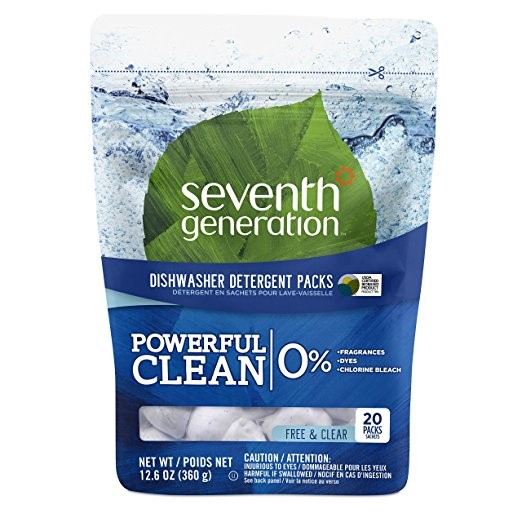 “At our house, we use several Seventh Generation products, particularly the Dishwasher Detergent Packs. These pods aren’t messy to put in the dishwasher, and they clean without chlorine, phosphates, or synthetic fragrances. “At our house, we use several Seventh Generation products, particularly the Dishwasher Detergent Packs. These pods aren’t messy to put in the dishwasher, and they clean without chlorine, phosphates, or synthetic fragrances.
—Rob Hanson, Membership Marketing Manager
“Dr. Bronner’s Sal Suds Biodegradable Cleaner is my favorite product for everything from washing the floors to washing my dishes. It’s gentle on the skin, is biodegradable, and just gets things nice and clean.”
—Dana Christianson, Membership Marketing Director

“For my secondhand antique furniture, I am in love with Howard products. The Feed-n-Wax Wood Polisher and Conditioner protects the wood but also ‘feeds’ it with essential oils to keep it strong. They also have a butcher block oil that is wonderful.”
—Christy Schwengel, Major Gifts Officer
“The Truce Pet Odor Remover Spray works like Febreze to get rid of the stink of dogs, but it doesn’t take a chemist to understand the ingredients. (Don’t use this if you have cats; they don’t like essential oils.)”
—Rachel Feldman, Business Partnerships Manager
“I use BioKleen’s Bac-Out for both stains on my clothes and when my cat gets sick on the carpet. It really works for smell and stain.”
—Beth Porter, Better Paper Project Director

“The Seventh Generation Free and Clear Natural Laundry Stain Remover is a friend to anyone who is clumsy. I’ve used it for lipstick stains and coffee spills. Once I use this, I never see the stains again.”
—Caroline Chen, Social Justice Programs Manager
“My stove has a ceramic top, and I’m constantly spilling or splattering things on it. EarthStone’s KitchenStone helps me get it clean without chemicals and without spending days scrubbing!”
—Tracy Fernandez Rysavy, Editor-in-Chief
“Molly’s Suds Liquid Laundry Detergent doesn’t have any dyes or fragrances, which I prefer as someone sensitive to scents. It’s really concentrated, so you can use less to get your clothes clean. And because it’s in a bag with a spout instead of a heavy plastic jug, it has a smaller eco-footprint.” prefer as someone sensitive to scents. It’s really concentrated, so you can use less to get your clothes clean. And because it’s in a bag with a spout instead of a heavy plastic jug, it has a smaller eco-footprint.”
—Kathy Harget, Development Director
|
|
Accountant |
|
|
WAMA Underwear |
Hemp basics. Natural and comfortable organic hemp underwear for men and women. Hemp boxers, hemp boxer briefs, hemp panties, hemp bikinis and more hemp undies. |
|
Vote Your Values, Use Your Proxy Power! |
Now more than ever we need to take advantage of every positive economic action we can to build an economy and society that works for people and the planet.
If you own company stock directly, be sure to add “proxy power” to your action list. Yes – you can vote to pressure companies to be more transparent about their conduct related to issues such as human rights, gun control, climate change, fair pay, corporate lobbying, and the diversity of corporate boards. Shareholders have a voice -- so by not voting your shares you could be making it easier for companies to continue unfair and harmful practices -- like underpaying women.
The main proxy voting season is in the spring, timed to shareholder meetings, so shareholders will soon receive their proxy materials and voting ballots via postal or electronic mail. Once again, approximately 400 resolutions, at dozens of companies, on crucial social, environmental, and corporate governance issues will be addressed.
Your vote matters – especially when it comes to supporting social and environmental issues that corporate managers typically urge shareholders to oppose on the ballot. Voting to increase corporate transparency on key issues affecting workers, communities, and natural resources is an important first step toward improving corporate behavior.
Voting your proxies makes a difference, as Andy Behar, publisher of the Proxy Preview notes: “….the Trump administration continues to weaken government regulations that protect citizens from environmental harms and provide basic social rights. More than ever, it is clear that investors who use their voices as a powerful force for positive change can make a difference at companies that want to thrive and survive in the future.”
If you want to better understand your proxy power – including recent shareholder resolution trends, the rise of new investor coalitions, and key themes in the 2018 proxy season, you’ll want your own copy of the 2018 Proxy Preview. Green America is proud to co-sponsor the Proxy Preview, a “must read” for anyone interested in the shareholder resolution process. You can download your free copy here.
The Proxy Preview explains shareholder resolutions in clear terms and provides context for understanding resolutions’ recent history, who filed the resolutions, as well as lists of companies and the types of resolutions filed at them by concerned shareholders.
Not sure how to read and vote your proxy ballot? Click here for Green America’s proxy voting tips.
Pay attention to your proxy materials – and vote your values!
|
|
Damiva |
Damiva is a women's health company making 100% natural products for a women. Damiva started when Chia Chia Sun was shocked to discover that the women's products on the drugstore shelf contained so many chemicals.
When she found out that 85% of women in menopause have vaginal dryness and that the dryness worsens over time, her obvious question was:
"What would I use for the next 30 years?"
She wanted a product that was safe, chemical free and hormone free, and when she realized that no such product existed, Chia Chia and Gardiner decided they would remedy the situation. Now it's become their shared passion and making healthy, 100% natural products for women's health and beauty at any age.
|
|
Nomadics Tipi Makers |
We have been making Sioux style Native American Tipis in beautiful Oregon since 1970. We offer exceptional craftsmanship and beautiful artwork. We are women owned and operated, with 85% women in the workforce. We only source organically grown cotton, use low VOC paint, recycle most of our by-products and support Native American causes via our ongoing 'WeCare' Projects. Nomadics pays living wages for everybody and offers above average benefits for its employees.
Our tipis are used as a space for meditation or quiet time, as a backyard gathering place, as permanent shelters for off-the-grid living, as airbnb or glampinghub rentals, as well as at Campgrounds, Retreat Centers, Educational Centers or Glamping Sites.
|
|
workforce equality badge |
|
|
Generic Badge |
|
|
ArT Wine Preserver |
Why ArT Wine Preserver? We believe you can enjoy & explore wine, without committing to the whole bottle in one night and without wasting a single drop. We exist to reduce waste and give you the flexibility to drink wine on your terms. Our engineering insight came from a background in the leading non-abrasive preservation technology in the food & wine industry. YOUR BENEFITS - Flexibility to open a bottle glass of wine with dinner on Tuesday
- Drink better wine
- Perfect wine gift for wine enthusiasts and lovers
WHO USES ART - Wine enthusiasts who don't always commit to a whole bottle (if you drink wine, this is YOU)
- Singles & those with traveling spouses
- Wineries, Tasting Rooms, wine professionals to preserve fragile sample bottles and brand
- Restaurants with strong wine lists
DIRECTIONS - Open wine bottle
- Drink as much or little as desired
- Spray 1-2 seconds of ArT in the bottle
- Re-cork the bottle using a wine stopper (DO NOT USE VACUUM STYLE - they do not seal well)
- Store wine bottle upright in a cool dark place.
ECO-FRIENDLY The packaging is fully recyclable (after it is empty) in most US states. Argon recycles itself back to the atmosphere. Buy ArT Wine Preserver now to Enjoy Your Wine - Longer |
|
Bed and Wood |
Bed and Wood is a high end online store for mattresses made from cotton and latex. Based in Oakton, Va., the founders grew up sleeping on surfaces from natural fibers and now share the passion of bringing these sleep products to American bedrooms. Pillows, mattress protectors and toppers complete their natural collection.
|
|
Corporate Lobbying Badge |
|
|
Clean Water Badge |
|
|
Holding Companies Accountable through Shareholder Activism |
There are many ways to pressure companies to improve their conduct. One important strategy is shareholder activism through the shareholder resolution process.
Every year concerned shareholders file resolutions on issues of concern related to important corporate practices and policies. These resolutions are an excellent way for corporate management to understand investor priorities on social, environmental, and corporate governance issues nationally and globally. Shareholder resolutions also help companies to identify reputational, financial, legal, or other risks that companies may face if the resolution is not addressed. Green America features examples of 2018 shareholder resolutions on issues like climate change and human rights, here.
Unfortunately, the shareholder resolution process is under attack by groups including the Chamber of Commerce and the Business Roundtable. They want to make it harder for investors concerned about corporate practices, especially those related to the well-being of people and planet, to be heard by corporate management. They seek to do this by making it harder for investors to resubmit shareholder resolutions over time. This means that corporate management wouldn’t have to face resolutions they typically oppose as frequently. And since the resolutions are disseminated to all shareholders, all investors would then be less informed about emerging risks to the company. The change would make it easier for corporate management to brush under the rug issues like pollution, human rights, and pay disparity.
On March 5, 2018 Green America sent a letter, excerpted below, to the Securities and Exchange Commission opposing the attack on shareholder rights and supporting of the shareholder resolution process currently in place.
We believe the rules that have successfully served the shareholder resolution process for decades continue to be effective and fair and are not in need of revision. Shareholder dialogues with corporate management and the submission of resolutions when warranted play an important corporate oversight role. The shareholder resolution process helps ensure the long-term value of US businesses by identifying potential risk and liability early on thereby supporting investor needs and the well-being of communities, consumers, workers, and the environment. Over the years, concerned shareholders have focused the attention of corporate management on crucial issues including risks associated with climate change, human rights, worker safety, corporate governance, and a wide range of other corporate responsibility and sustainability concerns.
At present, resolution resubmission thresholds of 3%, 6%, and 10% work well. Doubling or tripling these levels as requested, to 6%, 15%, and 30%, will only result in the loss of investor voice on key issues. The claim that continuing to put forward resolutions that receive under thirty percent is burdensome to companies is unproven. In fact, as of 2010, shareholders have resubmitted resolutions that earn less than 20% support for at least two years just 35 times and at only 26 corporations. Clearly there is no systemic problem or burden facing US companies on this issue.
Shareholders, as part-owners of the companies in which they invest, deserve an effective voice on the social, environmental, and corporate governance issues about which they care. Shareholder resolutions have improved corporate conduct and financial performance over the years and remain a useful tool for creating an economy that better serves us all. Green America urges the SEC to maintain the current shareholder resolutions resubmission thresholds.
As the 2018 shareholder proxy season gets underway, if you own company shares directly, be sure to vote your values on your proxies! For a quick look at how to read a proxy ballot, click here. Thank you for voting!
|
|
Clean Energy Badge |
|
|
Energy Badge |
|
|
Life Cycle Assessment on National Geographic Magazine's Paper |
The National Geographic Society began using recycled paper in their publications, thanks to a collaboration with Green America’s Better Paper Project and the Natural Resources Defense Council.
In 2013, Green America and NRDC joined with National Geographic on the most rigorous study to date of the benefits of using recycled fiber versus virgin fiber in magazine publications. Conducted by Environ International Corporation, an independent third-party for National Geographic, the study found that recycled fiber is superior to virgin fiber in 14 out of 14 environmental categories, such as energy use and greenhouse gas emissions. Since then, the groups have been working together to develop a plan to incorporate recycled content into the pages of the National Geographic magazines.
Read the full Life Cycle Assessment of Deinked and Virgin Pulp for National Geographic Magazine here.
National Geographic’s use of recycled paper in their magazines demonstrates that publications with world-class photography can use recycled paper without any compromise on quality. That means there are no excuses for any publishers to use virgin-fiber paper any longer.
The National Geographic Society has committed to using as much recycled paper in their magazines as possible. Their initial switch to paper with five percent post-consumer recycled content will:
- Lower their wood use by an equivalent of 26,000 trees.
- Use less energy – the savings equivalent to approximately 145 homes.
- Reduce their greenhouse gas emissions by the equivalent of 238 fewer cars each year.
- Lower their annual water consumption by about 19 Olympic sized swimming pools.
- Reduce their solid waste generation by about 33 fewer garbage trucks.
|
|
GAM New Green Tech 2018 Spring |
|
|
LivelihoodMatters |
I provide business consulting for socially responsible businesses and nonprofit organizations. By creating efficient, effective systems, job/time analyses, understanding metrics and success-drivers, and changing workplace culture, I help organizations increase revenues, have greater social impact and work less.
My home office is solar powered and I contribute at least 1% of revenues to environmental and micro-lending organizations for women entrepreneurs annually.
As the business grows, I expect to become a B Corp.
|
|
Proxy 2018 |
|
|
Methods of Regenerative Agriculture: #4 Composting |
This is the fourth blog of a series describing the five methods that make up regenerative agriculture—perennial plants & diverse crops, zero/low tillage & mulching, cover cropping & crop rotation, composting, and managed grazing. Implementation of these methods is site specific and depends on soil characteristics, crops grown, and local climates. Practices are rooted in organic methods and can be integrated into farms and pastures transitioning from conventional to organic. They also have a role in smaller-scale climate gardens, where individuals do their part to sequester carbon and contribute to a local, sustainable food system.
Regenerative Agriculture and Carbon Sequestration
All agriculture sequesters carbon from the air through photosynthesis. Regenerative agriculture ensures more carbon is stored than released and keeps the drawn down carbon underground. This effectively reduces the amount of carbon dioxide in the atmosphere and increases the amount of soil carbon available for healthy crops.
Composting
Composting is another tenant of regenerative agriculture. There is major potential for composting to provide beneficial outcomes both for the climate and beyond. Many agricultural practices are site-specific, but composting is one fundamental element of organic and regenerative agriculture that can be adopted by anyone growing and/or eating food. It is a practice that can be used on any size and type of food-producing operation, which is why it is one of the methods we encourage the most in regenerative agriculture.
Compost is made up of rich organic material, the result of decomposed kitchen scraps, farm and crop residues, manures, and yard wastes. When added to agricultural fields or mixed with garden soils, compost supplies a variety of nutrients, provides food for soil microbes, and creates healthier soils and crops.
The Benefits of Composting
The benefits for farmers and fields range from reduced costly off-farm inputs to greater resistance to pests and plant diseases. Soils’ ability to retain moisture increases, which means less irrigation is needed and less precious soil is lost to wind and water erosion. This is a win for climate change too, since composting results in soils with living ecosystems of micro-organisms that capture and store excess carbon, taking it out of the atmosphere and sequestering it where it can be used to enhance a farm’s productivity. This reduces the need for adding harmful, energy-intensive petrochemical pesticides and fertilizers. Diverting organic wastes from landfills also results in fewer methane emissions, helping reduce another more potent greenhouse gas.
If you're a climate gardener, you are likely already composting (and if you’re not, there’s no time like the present)! Some larger operations might need to source compost commercially (many need up to 20 tons per acre), but gardens at the home level can often be treated with compost generated from just your household and yard wastes. You can even ask your friends and neighbors to “donate” their organic materials if you fall a bit short! (Fun fact: Green America has a compost bin for our home gardeners to collect materials to take home with them.) When you compost, not only are you reducing the waste leaving your property and immediate community, but you’re also reducing the amount of funds spent on synthetic inputs. This makes for healthier homes and neighborhoods, with less chemical exposure and more pennies saved.
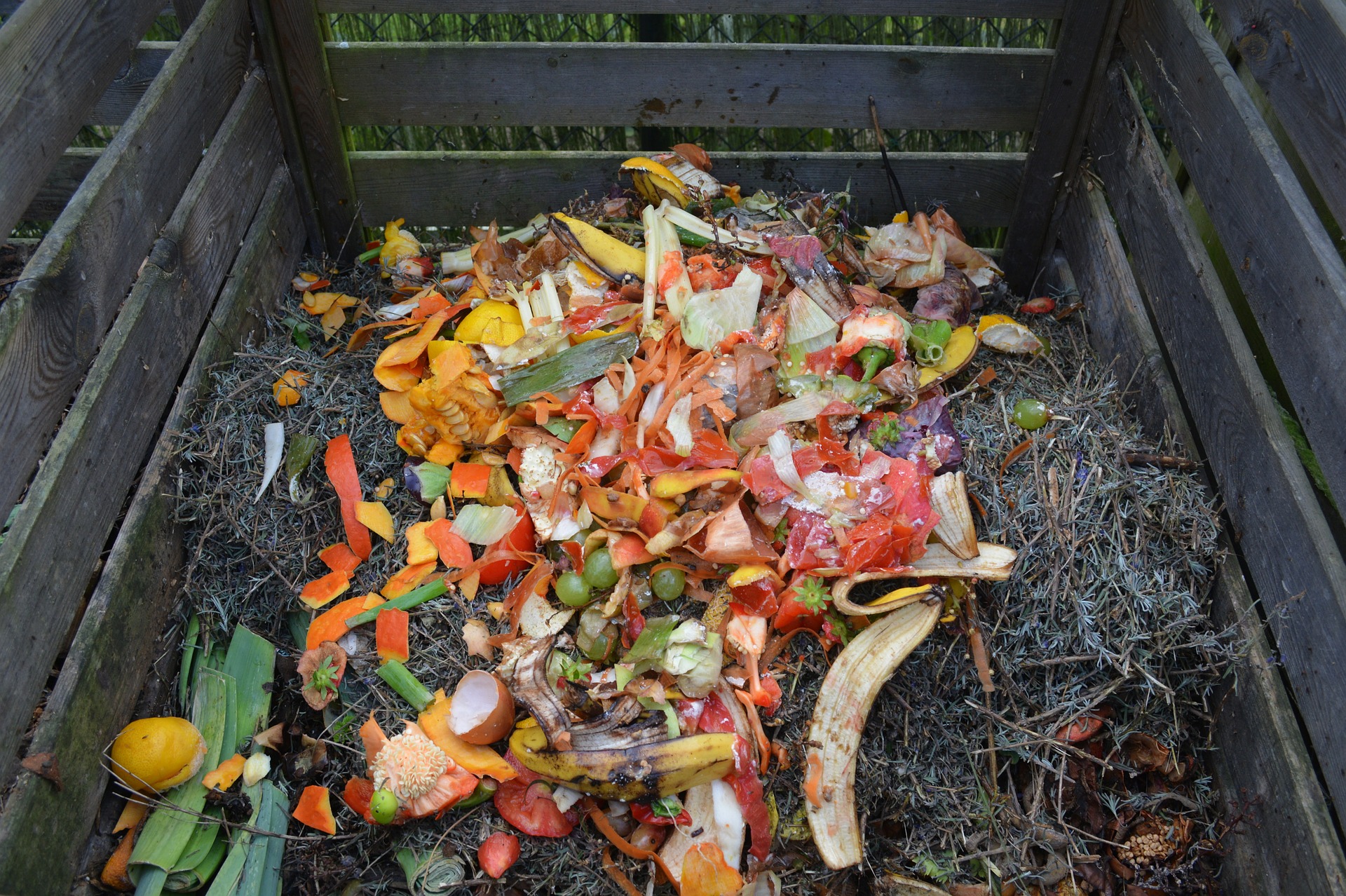 There are so many ways to compost and innumerable sources out there to help you. You might use bins, piles, pits, or other ways to store and mix your composting materials. You may employ the assistance of worms to create vermicompost. You could consider making a strong “compost tea” that can be used as a sort of liquid fertilizer that can be pumped into irrigation lines. The main things to consider are keeping temperature, moisture, and oxygen balanced, so as to ensure you’re creating a hospitable environment for the beneficial fungi, protozoa, bacteria, and other members of your local soil biome. You’ll also hear a lot about balancing your “browns and greens”—which refers to your carbon to nitrogen ratio, things like leaves, straw, sticks, and paper (carbon) and fresh greens or kitchen scraps (nitrogen) to further ensure this balance.
Whether you’re a consumer, farmer, or climate gardener, composting is your friend. It is one of the most important tools of regenerative agriculture and climate gardening and brings many benefits to local ecosystems and the people involved from production to consumption.
Finding a Composting Program
Don’t have a garden or space to compost? There are still options! If you’re unable to implement these practices directly, use your consumer power and speak with your dollars to show your support for these important practices. Additionally, you can advocate for city-wide or neighborhood-level programs for compost to be picked up (like how recycling and garbage is collected). There are also private services like this bike-powered compost business in Santa Cruz, California. You can find a local farm or garden that accepts organic materials to add to their composts. Don’t forget to let your local restaurants and grocery stores know how you feel about composting food wastes as well!
Composting is a great way to get active and engage with your community and local food system. Without strong signals from consumers, few farmers and businesses will switch to these practices in the timeframe needed to reverse current climate trends that threaten food security and the future of our planet.
|
|
Major Food Companies Join to Address Climate Change and Healthy Soils by Creating a New Standard Focused on Regenerative Agriculture |
LOS ANGELES (March 6, 2018) - The Carbon Underground and Green America, in partnership with Ben & Jerry’s (Unilever), DanoneWave, Annie’s (General Mills), and MegaFood have begun development of a global verification standard for food grown in a regenerative manner. The standard seeks to encourage farmers to restore the carbon cycle and build soil health, crop resilience, and nutrient density.
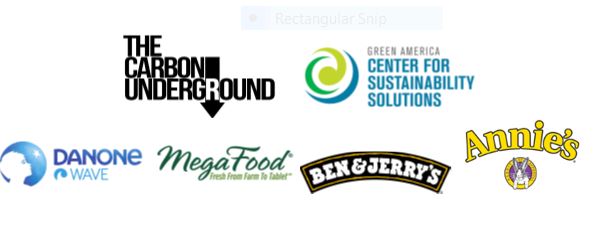
This work builds upon the Regenerative Agriculture Definition created in 2017 by The Carbon Underground, California State/Chico, and the Regenerative Agriculture Initiative that includes over 150 companies, organizations and scientists as signatories. The core
design team for the new standard also includes farmers, ranchers, soil scientists and certification experts and includes input and agreement from nearly 50 organizations on the goals of the new standard, which include:
- Ability to rapidly achieve impact
- Outcomes-based metrics, that can be verified and enforced
- Value, viability and flexibility for farmers, with credit for outcomes already achieved
- Clarity and transparency for supply chains
- Compatibility with related standards, such as Regenerative Organic, Organic, and Non-GMO. (Companies or growers who have invested in complementary standards will have those achievements recognized within this program, but they are not mandatory.)
- Flexibility for improvements as new data become available
“The goal of this new standard is not simply to restore soil, but to do it quickly,” said Larry Kopald, President and Co-Founder of The Carbon Underground. “The windows for avoiding catastrophic climate change and complete top soil loss are projected to close
in decades, not centuries.”
The key objective is to create a scalable, achievable standard that can work across the Global Supply Chain. Benefits of implementing these actions include greater food security, more stable supply chains, greater viability of farmers, and drawdown of
carbon from the atmosphere to mitigate climate change and rebalance the carbon cycle.
“By shifting to regenerative agricultural practices, which, by definition, work with nature, we can leverage photosynthesis to restore the water and carbon cycles,” said Dave Rapaport, Global Social Mission Officer at Ben & Jerry’s. “Working to avoid the
irreversible effects of climate change and the loss of our remaining top soil.”
For more information, or to sign up for updates, contact Randi Fiat atrfiat@thecarbonunderground.org or Ed Barker at ebarker@greenamerica.org.
About The Carbon Underground
The Carbon Underground was created to accelerate the restoration of soil and the transformation of agriculture to regenerative practices that will mitigate climate change, support farmers, and improve supply chains, food quality and food security around the
world. By working with businesses, scientists, governments and food producers The Carbon Underground creates and manages programs to reverse the threats of climate change, stop topsoil loss, and reduce supply chain stress.
www.thecarbonunderground.org
About Green America
Green America is the nation’s leading green economy organization. Founded in 1982, Green America provides the economic strategies, organizing power, and practical tools for consumers, businesses and investors to solve today’s social and environmental problems. Green America’s Center for Sustainability Solutions brings together diverse groups of stakeholders to solve the complex sustainability problems that no individual business, organization, or leader can solve alone.
www.greenamerica.org
www.centerforsustainabilitysolutions.org
###
|
|
Why Investing in Women Pays Off |
Leslie Samuelrich is the president of Green Century Capital Management, a socially responsible mutual fund company established in 1991 by a group of nonprofit advocacy organizations (specifically, eight state Public Interest Research Groups and the Fund for the Public Interest). Today, 100 percent of profits earned from its mutual funds belong to its nonprofit owners. Green Century’s funds are fossil-fuel-free and “invest in environmental innovators, while avoiding those that are environmentally negligent in their policies, processes, and products.”
Samuelrich’s article below was adapted, with permission, from a piece that first appeared in the November 2015 issue of Green Money Journal. Photo at right, from left to right: Erin Gray, marketing and strategic analysis; Leslie Samuelrich, president; and Wendy Wendlandt, board member and founding trustee. 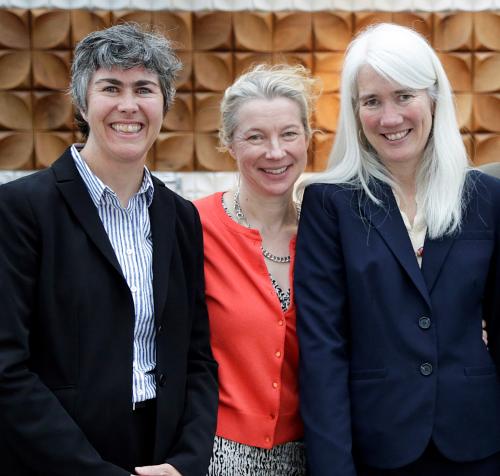
Companies that want to remain competitive must invest in women leaders. Several studies have confirmed that publicly traded companies with more women in leadership positions do better financially than companies with mostly male board members and executives. For example, Catalyst’s “Bottom Line” study, conducted from 2004-2008, found that “Fortune 500 companies with the highest representation of women board directors attained significantly higher financial performance, on average, that those with the lowest representation of women board directors.”
More recently, a 2014 study by Credit Suisse found that since 2005, companies with an above-average number of women on their boards outperformed companies with a below-average number by 3.7 percent on the stock market. Those results held true when Credit Suisse compared companies worldwide and within specific countries or regions.
A 2014 world survey conducted by human resources consulting firm DDI found that when women are in leadership positions in a company, not just at the top but throughout a company’s structure, those companies tend to perform better than companies whose structures are male-dominated.
A February 2015 analysis by McKinsey & Company of 366 public companies across a range of industries in North America and the United Kingdom found that companies in the top quartile for gender diversity were 15 percent more likely to financially outperform those in the bottom quartile.
Finally, the Barclays Women in Leadership Total Return Index is a broadly diversified bond index. Companies included in the index must have a female CEO or have women in at least 25 percent of their board positions. The index has outperformed the S&P 500 by 1.2 percent each year from July 2000 to July 2014. (The company offers an Exchange Traded Note that tracks this index.)
Studies demonstrating the value of having women in leadership provide helpful data to concretely back up what many of us already know from our experience—women can be strong leaders, communicators, problem-solvers, and staff managers who can help a company not only survive, but thrive. And shareholders can help encourage companies to put and retain more women in their top roles.
Exerting Shareholder Pressure
One of the easiest ways to invest in women is through mutual funds that invest in companies with women in leadership. At Green Century, for example, we actively support women’s leadership in the companies in which we invest and want to press more companies to do the same.
When Green Century analyzed its funds this summer, we found that the percentage of female directors and executives in the companies held by the Green Century Equity Fund and Balanced Fund handily surpassed the global average percentages of women on boards of directors and women in leadership positions. Women in leadership comprise 18.35 percent and 15.54 percent of the companies in the Green Century Equity Fund and the Green Century Balanced Fund, respectively, compared to a global average of 12.9 percent. The percentage of women on the boards of directors are 19.71 percent and 20.35 percent for the companies in the Green Century Equity Fund and the Green Century Balanced Fund, respectively. The global average of women on the boards of directors is 12.4 percent.
Mutual funds may also dialogue behind the scenes with companies and file or vote to support shareholder resolutions to encourage greater numbers of women in top positions.
If you own stock, watch for shareholder resolutions around improving gender diversity on corporate boards and in corporate leadership—and vote to support them. If you own mutual funds, it’s the fund managers who vote on shareholder resolutions. If you’re unsure about how your fund may vote, contact its investor relations departments and let them know you want the fund to vote in favor of resolutions promoting greater board and leadership diversity.
The Thirty Percent Coalition (see below), a national organization of more than 80 members committed to moving women into 30 percent of all board seats across publicly traded companies, filed 20 resolutions during 2015 aimed at including more women and people of color on corporate boards. In addition, Calvert Investments,Trillium Asset Management, and Walden Asset Management all filed resolutions requesting that companies report on existing or adopt new board-diversity policies.
The Thirty Percent Coalition
The Thirty Percent Coalition is a national organization of more than 80 members “committed to the goal of women holding 30 percent of board seats across public companies.”
Coalition members use three key stakeholder groups to influence corporations to hire more women on their boards: institutional investors wielding financial power, government officials with public-policy power, and corporate leaders with persuasive power.
The institutional-investor members have sent three rounds of letters to a list of publicly traded companies that have no women on their boards. They’ve also filed shareholder resolutions with companies that did not respond positively to the letters, calling on the companies to improve board diversity. Since the Coalition was created in 2011, more than 60 companies have appointed women to their boards as a result of Coalition efforts.
Not surprisingly, several of the pioneering socially responsible investment firms in Green America’s Green Business Network® are
coalition members, including Boston Common Asset Mgmt., Calvert Investments,Miller/Howard Investments, Pax World Funds, Trillium Asset Management, and Walden Asset Management.
Company Culture Matters
One of the most important ways companies can attract and retain women leaders is to create a culture that makes it possible for women to fulfill their work obligations and their roles as caregivers at home, for those who have children or are responsible for aging parents.
In her September 2015 New York Times opinion piece, New America Foundation president Anne-Marie Slaughter outlines how, although the US has “unlocked” the talent of its women at the high school and college levels, the ranks of those women still thin significantly as they rise toward the top, from more than 50 percent at entry level to 10 to 20 percent in senior management. Slaughter writes that “far too many discover that what was once a manageable and enjoyable work-family balance can no longer be sustained—regardless of ambition, confidence, or even a partner who shares tasks equally.”
She continues to drill down to a core problem that affects women, businesses, and our society: “Many women who started out with all the ambition in the world find themselves in a place they never expected to be. They do not choose to leave their jobs; they are shut out by the refusal of their bosses to make it possible for them to fit their family life and their work life together,” she writes.
At my prior job, at what would be easily considered a progressive organization with strong women leaders, there was no precedent or policy for parents to be able to work at home when I started there as a working mom. But we were doing such exciting work on corporate responsibility that I dug in to try to make the situation work.
Over time and with a supportive board, which was 50 percent female, the organization has adopted the accommodations they eventually made for me as policy. The result? An international organization that has tripled its budget and retained much of its top female leadership as they became mothers, and is a living example of how promoting women is good for growth.
Green Century digs deeper when we are reviewing companies for inclusion in our funds or engaging with them around an issue or potential shareholder resolution, asking how they attract and retain women. For example: Do they have flexible work time? Is there an informal or formal mentorship program for women? How many women stay after they have some kind of caregiving responsibility? In other words, the numbers matter, but so do the policies, culture, and details.
A Call to Action
It would seem that with all the information on the value of women in leadership, articles like this should be superfluous. Smart and strategic business leaders would have read these studies and already implemented plans that significantly increased the number of women in leadership.
But the roadblocks come up when that “change contradicts something we’ve long held as important,” says Brendan Nyhan, a professor of political science at Dartmouth who has studied how change occurs. If one has come to consciously or subconsciously believe that men are just better at being in charge, it can be more difficult to accept the fact that women also can lead effectively. In the end, Nyhan asserts that some people “can’t change unless the perceived consensus among figures we see as opinion and thought leaders changes first.”
If he is correct, then investors must attack this challenge together. And that means we must keep pushing. Pushing our firms, pushing our peers, pushing our boards, and pushing the companies in which we invest. We also need to support government policies that back the ideals with concrete support.
Why not start right now? As for why, I love paraphrasing the answer Canada’s new prime minister Justin Trudeau gave when asked why half of his cabinet is women: “It is 2015.”
—Leslie Samuelrich, with additional research by Tracy Fernandez Rysavy
SEC compliance information: Stocks will fluctuate in response to factors that may affect a single company, industry, sector, or the market as a whole and may perform worse than the market. Bonds are subject to risks including interest rate, credit, and inflation. The Green Century Mutual Funds’ environmental criteria limit the investments available to the Funds compared to mutual funds that do not use environmental criteria.
Past performance does not guarantee future results.
This information has been prepared from resources believed to be reliable. The views expressed are as of the date of this writing and are those of the Advisor to the Green Century Funds.
You should carefully consider the Funds’ investment objectives, risks, charges and expenses before investing. To obtain a Prospectus that contains this and other information about the Funds, please visit www.greencentury.com or e-mail info@greencentury.com or call 1-800-93-GREEN. Please read the Prospectus carefully before investing.
The Green Century Funds are distributed by UMB Distribution Services, LLC. 9/15
|
|
Common Interests |
Common Interests is an independent Wealth Management Practice specializing in sustainable, responsible and impact investing (SRI). The firm is a certified BCorp, and signatory to the UN Principles for Responsible Investing. With a healthy attitude of humility and service, we stand by our Mission Statement: “To enhance the financial wellness of our clients in a socially responsible manner by bringing to bear years of experience, knowledge and integrity.”
We have no minimum investment requirements and are absolutely focused on solving our clients’ financial problems…of all kinds. We provide services in all aspects of Comprehensive Financial planning for individuals, families, nonprofits and small businesses, in addition to Portfolio Design and Management. As a result of more than 20 yrs. in practice, we work well with families on a multi-generational basis to help them come together, share their worries and concerns, and ultimately, set clear financial goals for the present as well as the future.
All costs issues are clearly delineated and openly discussed. we invite you to visit our website, www.commoninterestsfinancial.com where we practice radical transparency about our fees and services. At Common Interests, financial planning is only the beginning. We are frequent speakers at national conferences, in university classrooms and local libraries. We firmly believe in being socially responsible in our investments decisions but also by treating others as we would want to be treated. An initial consultation with us is always complementary so that we can get to know one another, and work together to determine the best way forward.
|
|
Skye Investment Advisors, LLC |
Coming soon.
|
|
Shop green products and services in the Green Pages |
Shop green businesses that are certified members of our Green Business Network, so you know they care about people and the planet.
|
|
Clean Energy is Calling |
|
|
Verizon Flunks Green America's Scorecard Grading Wireless Companies on Clean Energy |
Green America Review Ranks T-Mobile Best with A-, Sprint Gets C, and AT&T C-; Verizon Gets “F” on Current Clean Energy Sourcing, Commitment to Improve, and GHG Emission Reductions.
Washington, D.C. – March 1, 2018 – Cell phone consumers concerned about clean energy and climate change will want to think long and hard about choosing or staying with Verizon, which got “F” grades across the board in a clean energy scorecard from Green America, the nation’s leading green organization working to solve environmental and social problems with economic solutions. T-Mobile came in at the head of the class with an A-, followed by Sprint with a C and AT&T with a C-.
Available online at https://www.greenamerica.org/report-clean-energy-calling, the Green America scorecard shows recent movement by T-Mobile, Sprint and AT&T in response to Green America’s Hang Up on Fossil Fuels campaign pressuring cell phone companies to improve their energy sourcing. Major telecom companies are starting to take action, beginning with T-Mobile’s historic pledge to shift to 100 percent clean energy by 2021. Within days of the T-Mobile announcement, AT&T announced a deal of its own, “one of the largest corporate renewable energy purchases in the U.S.,” and the company is purchasing 520 MW of power from two windfarms.
The telecom sector uses enormous amounts of energy each year. The four largest companies – AT&T, Verizon, Sprint and T-Mobile – collectively use more than 3 million MWh of electric power each year. AT&T and Verizon, the two leading U.S. companies in the industry, have a combined electricity usage that could power 2.6 million homes for a year. Yet, as of 2017, both companies were using less than 2 percent of alternative energy to power their massive servers, and this number is largely represented by natural gas. Sprint is using less than 1 percent renewable energy. Like AT&T, Sprint has pledged to improve its use of more climate-friendly fuel sources. Green America estimates that even with T-Mobile and AT&T’s new contracts for wind power, the industry will still only be powered by 15% renewables this year.
“Verizon is flunking when it comes to adopting renewable energy, and AT&T and Sprint aren’t doing much better,” said Todd Larsen, executive co-director of Consumer and Corporate Engagement at Green America. “T-Mobile deserves credit for stepping up and being best in its class. To reduce our climate emissions at the speed and scale necessary to address the climate crisis, all companies should shift to 100 percent renewable energy within the next decade. If companies like Apple and Google can achieve 100 percent clean energy, telecom companies can too.”
Green America’s Wireless Scorecard
Based on publicly available data and information provided directly to Green America by companies, each of the companies are is graded on core metrics related to efficiency, clean energy and greenhouse gas emissions reductions.

“The availability of wind and solar energy in the U.S. is growing while the cost is shrinking,” said Beth Porter, climate campaigns director at Green America. “T-Mobile said it will save $100 million from the shift to renewables. On top of reducing carbon emissions, moving to renewable energy is a sound business decision.”
From the report: “Only one major telecom company, T-Mobile, has made a commitment to move to 100 percent renewable energy. Shortly thereafter, AT&T announced the purchase of 520 MWh of wind energy, which we estimate will take its overall consumption of clean energy to approximately 20 percent of total energy used. Verizon and Sprint are both utilizing less than 2 percent renewable energy. Even with its stated commitments to double its renewable energy commitments over the next decade, Verizon will still be using less than 4 percent clean energy. Verizon has not made any notable commitments to clean energy or greenhouse gas reductions and is the laggard in the telecommunication industry on this issue.
“AT&T, Verizon, and Sprint have all lowered their energy intensity (increased efficiency) over the past decade. … However, in comparing the four companies regarding their energy intensity in relation to revenues or customers, AT&T and Verizon use far more energy per revenue dollar or per customer than Sprint or
T-Mobile. …
“AT&T and Verizon have not set goals for reducing overall emissions. Sprint made a commitment to reduce overall emissions by 20 percent by 2017, and more than doubled that target with a reduction of 47 percent. With its recent commitment to 100 percent renewable energy, T-Mobile will realize an unspecified reduction.”
ABOUT GREEN AMERICA
Green America is the nation’s leading green economy organization. Founded in 1982, Green America provides the economic strategies, organizing power and practical tools for businesses and individuals to solve today’s social and environmental problems. http://www.GreenAmerica.org
MEDIA CONTACT: Max Karlin for Green America, (703) 276-3255, or mkarlin@hastingsgroup.com.
EDITOR’S NOTE: Video can be found here of T-Mobile CEO John Legere’s 100 percent renewable announcement and support for Green America’s Hang Up on Fossil Fuels campaign at https://youtu.be/XJgTB4afPvI.
|
|
At Home with a Green Architect |
From the front, Bill Hutchins’ small bungalow looks much like the rest on his street in Takoma Park, MD. But the 2,100 sq.-foot house Hutchins shares with his wife and their three children (with an apartment that they rent in the basement) is a green home, built with eco-friendly features and with environmentally low-impact practices that limit toxins and waste. To Hutchins, homes have the potential to have soul, especially when they’re designed and built thoughtfully and with heart. He knows because he’s both homeowner and architect, and he is also the owner of Helicon Works Architects. Hutchins incorporated elements in designing his home that have been available to consumers for years. Yet, it feels so different from a conventionally built home that it’s clear green is still on the cutting edge.
Below, watch associate editor Eleanor Greene go on a tour of the house with Bill.Or watch on Facebook.
Three Decades of Green
 Hutchins started Helicon Works 28 years ago, when his young daughter’s spirit for life made him realize his own had faded. He began to read poetry and essays about life’s journeys, and from those, he saw “home” as something each person holds inside, which can be mirrored in the buildings they live in. Hutchins says his work as an architect is now that of “a poet who writes with space and form.” Hutchins started Helicon Works 28 years ago, when his young daughter’s spirit for life made him realize his own had faded. He began to read poetry and essays about life’s journeys, and from those, he saw “home” as something each person holds inside, which can be mirrored in the buildings they live in. Hutchins says his work as an architect is now that of “a poet who writes with space and form.”
In fact, in 2018 Hutchins published his first book, Dwelling, a collection of writings by Hutchins and others that is a “poetic exploration of home.”
The book, which he published through Washington, DC, bookstore Politics & Prose, is a collection of poems, short essays, and photos that touch on connections between people and the Earth, and people and their homes, while also exploring how people may find home inside themselves.
In coordination with the book's release, Hutchins launched Dwelling events and workshops out of his home. The workshops, the first of which took place in May, help people reassess their connections with their homes, forge better relationships with them, and live mindfully.
Even before his daughter inspired him to reenergize the creative aspect of his work, he says he was always a green-minded person and architect. He grew up “playing in the dirt,” literally and figuratively, and has long been aware of being Earth-minded in his life. When he started his practice, he incorporated new green principles as he discovered them, such as eliminating toxic formaldehyde and placing a priority on sustainably sourced wood.
In his entire three-decade journey as an architect, Hutchins says that designing and doing a green whole-house renovation on his own home was his “big bang” moment, where his thoughts and insights about how to blend his work with his values and his creative views on what makes a home “burst into clarity.”
Inside the Hutchins Home
As you walk from the street to the main door on the side of the house, you can see it’s not just a regular house. The exterior wall that’s not visible from the street is painted green, purple, and bright gold. (He lives in a historic district and was not allowed to make changes to part of the house that was visible from the street during his renovation in 2006.)
The tiled stones on the walkway are courtertop fragments, flipped upside down, which he salvaged during a dumpster dive. The pavers in the mudroom and the back terrace are from Community Forklift, a nonprofit that sells surplus, gently used, and salvaged supplies for home improvement.
 Even on a frigid day, the house is warm, thanks to the corn-fired stove in the corner of the kitchen, the room at the center of the house. Using corn is cheaper than heating with oil and produces fewer greenhouse gas emissions. Every couple of weeks, Hutchins or his wife gets organic, locally sourced corn, purchased through a cooperative, for the stove from a pickup point. The stove uses about a bucket of corn per day in the winter. Even on a frigid day, the house is warm, thanks to the corn-fired stove in the corner of the kitchen, the room at the center of the house. Using corn is cheaper than heating with oil and produces fewer greenhouse gas emissions. Every couple of weeks, Hutchins or his wife gets organic, locally sourced corn, purchased through a cooperative, for the stove from a pickup point. The stove uses about a bucket of corn per day in the winter.
The kitchen counter is splashed with color from salvaged mismatched tiles, and in the mudroom, closet doors came vintage from the Pentagon through Community Forklift. Buying salvaged materials saves money, and it also saves resources, compared to buying new doors or a slab of quarried marble for countertops.
The cabinet doors have a unique, sculptural look, which Hutchins said was achieved by cutting two-by-fours into wavy patterns, sanding them down, and nailing them together. Because they’re made from whole pieces of wood, not compressed fibers, they’re quite sturdy.
The Hutchins’ addition to the historical part of the house included a kitchen and sunroom downstairs, and two bedrooms and a porch upstairs. But the walls on the addition aren’t made of drywall—they were built using straw bale construction, a method that involves stacking up bales of straw and plastering it inside and out to protect it from the elements.
The processes of growing hay for straw and of making plaster are far less energy-intensive than acquiring resources for other building methods, and neither requires toxic materials. A straw bale wall can last just as long as conventionally built one and provides insulation at a lower price.
“It’s cellulose, like wood. If you protect it and keep it dry, it will last as long as we will, maybe longer,” Hutchins says. “For me, everything has to start with beauty. If it’s not beautiful, nobody’s going to want to do it. Fortunately, straw bale is a very beautiful way to build. These very thick walls just have a life force to them. A lot of the walls we live with and the food we eat have no life force, so this is a beautiful way to give a home vitality.”
.jpg) The result of the straw bale construction looks more earthy than conventional construction, especially in Hutchins’ house, which volunteers helped build in exchange for lessons on green building practices. The plastering isn’t perfectly flat, giving the walls a lively texture and unique style. The result of the straw bale construction looks more earthy than conventional construction, especially in Hutchins’ house, which volunteers helped build in exchange for lessons on green building practices. The plastering isn’t perfectly flat, giving the walls a lively texture and unique style.
For the stair railing, Hutchins enlisted the help of Salvaging Creativity, a metal-working group in York, PA, that’s part of the Helicon Works
collaborative. Using sketches from Hutchins and salvaged metals, the company created an artistic railing and door handles in Hutchins’ home without the impact of new metals.
Rain barrels in the backyard collect runoff for use in the garden. A collection pond captures water that would normally run downhill and pool in the basement, turning it into a habitat for birds and other animals.
“Storm water management is important in urban and suburban areas,” says Hutchins. “We developed a holistic plan to keep all rainwater on our site—from the pond, to a bog, to a rain garden, to a trench drain under the driveway with pervious pavers.”
There are areas in Hutchins’ home that he’d like to make even more eco-friendly. He’d love to upgrade the front windows to better insulate the house, but he can’t because of the historic neighborhood’s rules. The rest of the windows, however, are salvaged from builders who bought too many and would have wasted them otherwise. Using “orphaned windows” saved Hutchins about $12,000.
Rooftop solar panels fulfill about 15 percent of the house’s electricity needs. And overall, he’s done what he can to make the home energy efficient.
“We created high-density living, with between five and eight people living here, and my wife and I work at home,” says Hutchins. “Our energy use is high, but a lot happens here!”
He notes that his house is very well insulated. In fact, that’s the green quality that has saved him the most money. The EPA estimates a well-sealed home with good insulation can save homeowners 15 percent on heating and cooling costs, but Hutchins admits he hasn’t really kept track of exactly how much he’s been able to cut down on his energy bills. He just does what he believes is the right thing to do.
 Green with Heart Green with Heart
Though Hutchins’ home is what most would consider to be green, he emphasizes it’s far from perfect. Getting to green is a journey, he says.
“The thing about green building is that there are no right answers—there are shades of green. We’re learning, and technologies are catching up. For me, it’s about consciousness. If we have a consciousness and a heart to honor the Earth and each other, that’s what we’ll do.”
|
|
Clean Energy Is Calling Report |
|
|
The Color of Justice |
The nonprofit Color Of Change (COC) calls itself “the country’s largest online racial justice organization.” Formed in the weeks following Hurricane Katrina by activist James Rucker and current progressive CNN host Van Jones, COC aims “to respond to injustice and move decision-makers in corporations and government to create a more human and less hostile world for Black people in America.” Its campaigns focus on achieving racial, media, and economic justice, as well as working to reform the criminal justice system.
The group has brought about several important victories in its ten years of operation, which include pressuring news networks to drop Lou Dobbs (CNN), Glenn Beck (Fox News), Pat Buchanan (MSNBC), and Bill O’Reilly (Fox News) off the air in light of ongoing racist commentary. The staff helped get justice for the “Jena Six” a group of Black teenagers who COC says were excessively charged and sentenced after defending themselves during a campaign of racist harassment at school. They’ve gotten Clear Channel to remove vote-suppressing billboards from Black and Latin-American neighborhoods. They successfully pushed for the removal of the confederate flag from the South Carolina state capitol. And they’ve weakened the American Legislative Exchange Council (ALEC), which the group calls a “dangerously effective” right-wing policy group that is responsible for funneling corporate dollars to politicians to create laws that roll back worker rights and environmental protections, and that “dismantle the gains of the Civil Rights movement.”
Like Green America, Color Of Change runs campaigns that hit companies in the pocketbook, as the group presses for corporate accountability. The group has also started embracing divestment as an activist tool, helping to encourage investors to divest $60 million from the private-prison industry.
Green America has worked with Color Of Change to promote the group’s Blood Money campaign (see more, next page) and its action last year to pressure corporate CEOs to leave Trump’s business councils.
Green America’s Tracy Fernandez Rysavy talked to Brandi Collins—who holds a law degree from the University of Wisconsin-Madison and is Color Of Change’s senior campaign director for media, democracy, and economic justice—about her work, the group’s important wins, and how economic justice and civil rights are inextricably intertwined.
Green American/Tracy: Color Of Change was founded in part as a response to Hurricane Katrina. How has your mission evolved since then?
Brandi Collins: I don’t know that the mission itself has evolved. I think the core is always going to be to build power for Black folks and redefine the rules of what’s possible in our society, although we definitely see through a wider lens than just Black folks. We know that in order for us to achieve justice, we all have to win. Communities left on the margins have to win.
If anything, we’ve reaffirmed our mission as we see more and more the structural inequities that continue to work against us and keep us from moving forward toward a collective vision of another world where anything is possible. Where the American dream can feel real for all of us and not just a lucky few.
Green American/Tracy: What do you see as the connections between economic justice and civil rights?
Brandi Collins: At the end of the day, to me, everything is a combination of an economic or a media justice issue. So even when you talk about environmental justice and who suffers, where corporations feel comfortable dumping toxic waste and who they feel will suffer in silence, and why coal mines are built near certain communities, and why Black and Brown kids have higher levels of asthma, oftentimes, that comes down to an economic justice issue.
All of these different issues—whether tax or economic policies that you see on the local or federal level, or paid child care subsidies, or who most benefits from a tax credit, like the ones we’ve seen rolled out by this administration, versus social safety net programs—are both civil rights and economic justice issues.
Green American/Tracy: Your executive director Rashad Robinson has said that Color Of Change doesn’t just go after the Nazis and white supremacists—you go after the institutions that occupy the mainstream and make racism possible. Can you elaborate?
Brandi Collins: It’s tied to something the leadership here has thought deeply about, and that’s about understanding leverage as means to build power.
It’s not enough to stop who’s causing the pain. But [we have to look at] who benefits from the pain. We’ve seen very acutely the role that Silicon Valley and financial institutions have played in allowing white nationalism to thrive.
[For example], as we go online, information is gathered about us to create a data profile. Everything we click on, every article we share, every pair of boots we buy works toward creating this profile of who the internet thinks we are.
A story that we saw consistently with Dylann Roof [the white supremacist who murdered eight Black churchgoers and their pastor in Charleston, SC, in 2015] and others is of someone who has questionable views on life, or people of color, Black folks, and becomes increasingly more radicalized through their online experience.
The more the internet receives you as someone with white nationalist, alt-right views, the more it’s like, “Well, here are ten more people you can follow on Twitter who have more radical views than you. Here’s a bunch more articles you can share with your friends that talk about Black-on-Black crime or other false narratives.”
It radicalizes people. When you think about it through that lens, then there’s a certain amount of accountability that Silicon Valley needs to have.
A white nationalist doesn’t care about what Color Of Change thinks about their views. But Silicon Valley cares what Black and Brown folks think of them because they want our money, they want our data. So we have more leverage over them.
 Same thing with our Blood Money campaign, [which asks the major credit-card and payment-processing companies to cut off hate groups from their financial services]. We worked with the Southern Poverty Law Center to discover that a lot of white nationalists were using PayPal and different financial institutions to support their sites—to be able to expand, to be able to go into places like Charlottesville, Berkeley, Portland, and create chaos. Same thing with our Blood Money campaign, [which asks the major credit-card and payment-processing companies to cut off hate groups from their financial services]. We worked with the Southern Poverty Law Center to discover that a lot of white nationalists were using PayPal and different financial institutions to support their sites—to be able to expand, to be able to go into places like Charlottesville, Berkeley, Portland, and create chaos.
Now it’s not like these financial companies can say, “Well, we’re making billions and billions of dollars off of white nationalists, so we don’t want to mess with our bottom line.” They were making pennies on the dollar.
But for those white nationalist groups, that $200,000 that they bring in each year allows them to keep their site open, allows them to travel to all sorts of places, allows them to amplify their message of hate.
Again, do they care about Color Of Change or what Black people think about what their site is doing? No. But do financial institutions care that millions of people are coming to them and saying, “We’ll cut up our credit card today. And we’re going to go out and talk about how you have blood on your hands because of Charlottesville, because the [white nationalist perpetrators] used money they got through your financial system in order to go there in the first place”?
Now the financial companies want to have a discussion. Now they’re able to cut off the financial flow that’s allowing these groups to thrive.
[Editor’s note: In August 2017, as white nationalists converged on Charlottesville, VA, for a rally, one drove his car through a group of counter-protestors, killing activist Heather Heyer and injuring 35 others. As the Green American reported in our Fall 2017 issue, all four major credit card companies, as well as PayPal and Apple Pay, have agreed to cut off white supremacists from their services. Color Of Change notes that they still have hate groups using their services, and it continues to pressure the companies to develop and implement an anti-hate Acceptable Use Policies and divert resources to enforce them.]
Green American/Tracy: Can you talk a bit more about your work pressuring social media companies, as well?
Brandi Collins: We’ve had a lot of different conversations with companies in Silicon Valley. Eventbrite was one interesting campaign we ran last year. We noticed that a lot of white nationalist groups and individuals were selling tickets through Eventbrite. Again, this is pennies on the dollar for Eventbrite, but it allows white nationalists to amplify a message of hate.
So we reached out to Eventbrite, Facebook, Twitter, and to their credit, all of these entities have shown a willingness to talk with us, and to say, “This doesn’t align with our values. What can we do?”
We’ve also done a lot of interesting work with Airbnb because of the online discrimination that was happening [against renters] on their platform. That’s one corporation that really came to the table and said in our meetings, “We’d rather leave money on the table and get this right than get this wrong.”
Oftentimes, these are behind-the-scenes conversations that might result in different policy changes in their most positive form. But if I’m being completely honest, there’s still so much work to do.
Green American/Tracy: You’ve also worked on diversity issues, getting Twitter to release diversity data in 2014. Why is diversity at the highest levels of a company so important?
Brandi Collins: I want to be clear we never call for diversity just for diversity’s sake because a Black face in a white place doesn’t always ensure equity.
What we’ve seen time and time again is that when judgments are being made—Is this racist? Is this a problem?—there are certain things that go over people’s heads when they haven’t had that same level of experience.
With Facebook, for example, there was a ProPublica article that came out last year where ProPublica flagged for executives at Facebook around 50 pieces of hateful content on their site that had been reported by users but were allowed [by Facebook’s Community Standards team] to stay on the site.
Facebook admitted that almost half the time, they had gotten it wrong. Their response was, “We’re hiring more and more people.” But who are you hiring? Are you hiring someone who understands implicit threats rather than explicit? Who doesn’t need to see the N-word to know that something is hateful content?
Also, when Facebook, Twitter, Airbnb, and others are making decisions around the type of platform and the user experience, whose user experience are they taking under consideration?
When Uber makes a call that says they’re going to advertise in New York as, “Uber, cheaper to get to work than the train,” but they’re not willing to go into neighborhoods where people might actually benefit from being able to travel to work at a cheaper rate, what does that mean? How are we actually moving the equity of user experience?
By having diversity at all different decision points, it ensures that more of those discussions can happen internally, and you don’t have to have a Color Of Change knocking on your door when you’ve messed up, and our million members asking you what’s really going on.
We’re also doing some work around Hollywood diversity. Late last year, we released a report where we looked at the state of Hollywood writer rooms. What we see on TV and in our theaters matters.
For many people, they go through life without necessarily having an experience of what it means to have a person of a different ethnicity close to you in your life. So for a lot of white people and other folks, your experience of Blackness or what it means to be Latino or Asian is informed by what you see in the news and on TV, not necessarily by your neighbor.
Who’s in the writing room, and who’s telling those stories, and how people of color are being depicted matters.
We’re also doing work in diversifying newsrooms, because the “fake news” witch hunt led by this current administration has elevated certain mainstream news outlets, and we conveniently forget some of them are the worst when it comes to perpetuating harmful stereotypes around low-income communities and communities of color.
We released a report last year that talked about how Black families are depicted in the media. There were some interesting findings, not just things you expect to see from the more right-wing media but from a New York Times or a CNN.
Green American/Tracy: I’d love to hear more.
Brandi Collins: The report looked at 800 stories published or aired between January 2015 and December 2016 from national broadcasts and cable news outlets—ABC, CBS, NBC, the Washington Post, MSNBC, the New York Times, USA Today, and other online news sites. This study also correlated with election cycle, so these are the stories that were popping up as certain candidates were emerging.
When the media outlets we examined reported stories about poor families, they chose to feature Black families in their report nearly 60 percent of the time, even though only 27 percent of families living below the poverty line are Black.
Similarly, in coverage of welfare, 62 percent of families portrayed were Black, even though 40 percent of families receiving welfare are Black. Some of the worst offenders were Fox, CNN, the New York Times, and Breitbart—less surprising with Fox and Breitbart, a little more surprising around CNN and the New York Times.
There’s this deliberate decision-making that’s putting a Black or Brown face on poverty and on stories about who gets government benefits. Couple that with a narrative that we see consistently in media, shaped by our society, that anybody who does receive benefits or is involved in social safety-net programs is draining the system. They’re not seen as being important members of our society.
Also, poor folks are often not shown as working. But most poor folks are actually working; many have more than one job and still are not able to make ends meet. Instead of questioning why that is, there’s this built-in assumption of laziness.
When you look at whose faces are being shown when those messages are sent out, it tells a devastating story that has deep impacts from a policy standpoint, from all sorts of standpoints.
Green American/Tracy: You’ve also looked at local newsrooms as well?
Brandi Collins: When we were looking at local news, we did a report in New York, where we found that every station was over-representing Black crime by as much as 77 percent and dramatically under-reporting white crime.
There’s also another study done by our friends at the National Hispanic Media Coalition, who have led a number of different initiatives looking at the B-roll news stations use, and who’s on that B-roll, and who are spokespeople they go to, and what stories are being told. They found that every time police officers are up for budget renewals, they intentionally feed a higher level of super-predator crime stories to local stations.
The news stations are not even vetting these stories for themselves, or making distinctions like, “Are we showing an over-representation of Black folks?” They’re getting handed a stack of stories by police departments that are often disproportionately Black and Brown people, and they’re airing them.
That, coupled with a spike in super-predator stories overall means that there’s still a lot of work that still has to be done around humanizing our people. And in continuing to call out our elected officials and judges who use that sort of rhetoric as justification to pass or uphold harmful laws and legislation.
Green American/Tracy: How has Color Of Change used divestment as a tool for social justice?
Brandi Collins: I definitely want to get more into shareholder divestment. Our criminal justice team has done some work around divesting from the private-prison industry, including explicitly calling on political candidates to say that they will not accept money from the private-prison industry, especially if they want people of color to vote for them. Hillary Clinton had announced she would not when she was running her candidacy. That was some work happening behind the scenes from Color Of Change and others.
Another campaign that I ran early on in the election cycle called on corporations to divest from the Republican National Convention [because of Trump’s xenophobic and racist rhetoric], which is a little bit different from what we typically think of when we have conversations around divestment. We called for corporations to say they will not carry water for white nationalists and will not treat [hate speech] as business as usual when it’s not business as usual.
When we have a president that calls—excuse my French—Black and Brown countries “sh*thole countries,” and you as a corporation continue to sit down with him even as you rely on our dollars to exist, something’s not right there.
Green American/Tracy: Why is it so critical to divest from private prisons?
Brandi Collins: The prison industrial complex, in general, is a system that’s built on an economy of filling beds. What does that mean for our communities? Some of the things we’ve seen happening and the conditions we’ve seen in for-profit prisons are appalling, and they don’t have even a remote level of accountability that maybe public prisons would.
They’re all funded by venture capitalists, and their ability to make money depends on putting someone in cages at the lowest possible cost to maximize their profit. When we use that as a structure, there’s immediately a huge problem in terms of what sort of treatment incarcerated people receive, and what are the motivations to re-incarcerate and the de-motivations to invest in programs geared toward lowering the likelihood that someone will come back to prison.
By the time they go through these horrible prison conditions and are coming back into society, there’s no soft landing. Before you even walk out the door, you don’t have a chance to succeed, and they’re warming up a bed for your return.
Private prisons perpetuate that cycle in a number of different ways, whether it’s people who are unable to stay in touch with loved ones, who are incarcerated so many miles away from their families, and even if their families do want to stay in touch, they’re unable to travel. Whether it’s many of those costs being pushed back on already poor communities, like forcing them to pay for phone calls and food, or all sorts of things. It’s just a bad system.
Green American/Tracy: What can white “allies” and non-Black people of color do to support Color Of Change’s work and civil rights in America?
Brandi Collins: A lot of different things. We know anecdotally we have a pretty multiracial membership. So if you join Color Of Change, we provide a lot of opportunities for you to stay engaged and a lot of different activation points in your community.
For folks who can give a little, consider giving to organizations of color. And definitely look to the leadership that is emerging from those spaces. We have always seen and continue to see an incredible amount of young, old, multiracial, diverse, LGBTQ leadership. We need to challenge ourselves to be led by those folks.
I also want to mention our work at OrganizeFor.org. This mechanism allows people to start their own petitions. If you see an injustice happening in your community, and you want to do something about it, start a petition, and we will talk to you and help you move from a petition to a win in your community.
They always say social justice people are like cynical optimists. We have to believe another world is possible. I am surrounded and uplifted by all the people doing this work. Maybe we can’t imagine that other world because maybe we haven’t experienced that other world. But the fact that we keep striving toward it and coloring it in a little gives me hope.
Connect with Color Of Change at ColorofChange.org. Sign on to the group’s Blood Money campaign at bloodmoney.org. And start your own Color of Change petition in your community at OrganizeFor.org.
|
|
Plant a Garden, Cool the Planet |
During WWI and WWII, Europe’s ravaged farmlands were no longer capable of producing large amounts of food, which led to a famine that affected Allied soldiers. In 1917, under the leadership of President Woodrow Wilson and then head of the US Food Administration, Herbert Hoover, the US government asked its citizens to support the war effort by starting “victory gardens” to grow their own food so that more food exports could be sent overseas.
Today, leaders in Green America’s (Re)Store It! campaign are promoting the same sense of urgency and collective action by encouraging people to plant “Climate Victory Gardens.” Rather than assisting in a war effort, these local gardens help combat an impending threat that jeopardizes everyone: climate change.
Not just any old garden will have the climate impact Green America aims for with this campaign. The key to transforming traditional community gardens and urban farms into climate gardens, or gardens capable of sequestering carbon, is in embracing gardening principles that protect soil health and biodiversity.
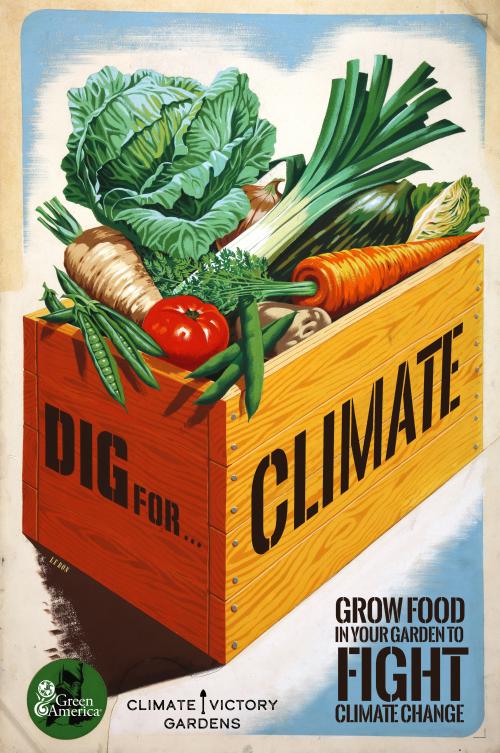 Newly launched, (Re)Store It! aims to promote regenerative agriculture, a type of farming that turns dead or degraded dirt into rich, biodiverse soil that acts as a carbon sink. A worldwide switch to regenerative farming could reverse climate change. Scientists with Project Drawdown, a nonprofit founded by bestselling author Paul Hawken, conservatively estimate that regenerative agriculture will increase by 1 billion acres by 2050, which would draw 23.2 gigatons of CO2-equivalent from the atmosphere. Newly launched, (Re)Store It! aims to promote regenerative agriculture, a type of farming that turns dead or degraded dirt into rich, biodiverse soil that acts as a carbon sink. A worldwide switch to regenerative farming could reverse climate change. Scientists with Project Drawdown, a nonprofit founded by bestselling author Paul Hawken, conservatively estimate that regenerative agriculture will increase by 1 billion acres by 2050, which would draw 23.2 gigatons of CO2-equivalent from the atmosphere.
“We wanted a tangible way for people to engage with our (Re)Store It! campaign,” says Green America food campaigns director Anna Meyer. “Climate Victory Gardens are a way for everyone to help turn soil into a powerful carbon sink.”
The campaign asks gardeners to commit to ten regenerative gardening principles that serve both the environment and the soil. Each climate victory gardener makes a pledge to: grow edible plants, keep soils covered, encourage biodiversity, plant perennials, ditch chemicals, compost, integrate crops and animals (not a must, but integrating animal manure and possibly chickens can make soil richer), use people power and not mechanization, rotate plants and crops, and get to know their garden and understand its efficiency and what works best for it.
Following these principles leads to food production that supports the local economy and soil health, while curbing erosion, pollution, and pests, increasing water retention, and decreasing runoff.
Meyer notes that soil health is literally the foundation of a thriving Climate Victory Garden. Healthy soil sequesters much more carbon than dead dirt.
“It’s about making sure that you’re growing a diverse amount of plants and that you’re building up soil that has major biodiversity in it,” she says.
Meyer recommends that new gardeners get their soil tested, especially if they suspect there could be chemicals in it. For example, “if you’re living in an urban area with a history of lots of traffic, your soil could be very lead-heavy from when gasoline had lead in it, as recently as 1995,” says Meyer.
Urban food gardeners with contaminated soil may need to construct raised beds and bring in clean soil for safety. But, says Meyer, “if your urban soil is safe or easily rebuilt, our preference is for planting in the ground. It has more of an impact in terms of carbon sequestration and building up healthy, biodiverse soil.”
The Climate Victory Gardens campaign will soon launch a website that will link victory gardeners to more resources, including gardening instructions, equipment suggestions, and advice. It will also map climate gardens across the US.
Though likely small in size, Climate Victory Gardens have the potential to enrich entire communities. The increase of local food production spurred by gardens also cuts down on the transportation needed to export foods into various cities, thereby reducing CO2 gas emissions. And as people learn about the importance of climate gardening at home, Green America hopes they will start demanding food grown with regenerative techniques.
“It goes along with the saying that it’s not about a stone; it’s about the ripple it creates,” says Meyer. “In the case of Climate Victory Gardens, that ripple spreads outward in the form of community engagement and educating a generation about climate change—all while we work together to stop the climate crisis.”
|
|
Smart Homes and Privacy |
Your computerized car can pinpoint where you are as you drive. Your wireless computer and phone have microphones and cameras that hackers could access. Your smart TV collects data on your viewing habits to better target you with ads. Smart home devices promise convenience, but they also carry the danger of whittling away at our privacy.
In addition to exercising care with connected, wireless devices for health reasons, it’s important to keep privacy considerations in mind when inviting connected devices into your home, as well as when investing in smart-tech companies, and when developing policy (or contacting your Congressional representatives about it).
A 2017 report from the Internet of Things (IoT) Forum asserts that manufacturers should do the following to protect people’s privacy: Only gather data with strong permission from customers. Be transparent about how they collect and use data. Keep explanations clear and simple, rather than vague. Delete data immediately once it’s been used.
The report also notes that policymakers must get involved in privacy protection. “Relying on market forces alone to embed strong privacy practices in the IoT is a flawed approach,” the report states.
In 2016, EU regulators created the General Data Protection Regulation (GDPR), to establish standards for data protection for products sold in the EU. US policymakers have been much slower to act. In March of 2015, the Federal Trade Commission (FTC) created a devision to study the links between smart devices and privacy. And this past August, four Senators introduced the bipartisan Internet of Things Cybersecurity Act, which would require devices sold in the US to meet minimum security requirements. It’s not as robust as the GDPR, but it does ensure that devices include some security protections against hackers.
At least 42 states introduced more than 240 bills or resolutions in 2017 related to cybersecurity, including those that would instill mandatory protections from cyberattacks and rules for the disposal of data a company collects.
As US consumers wait for privacy laws to catch up with smart technology, it’s important to take steps to protect yourself.
At Green America, we advise purchasing “more stuff” only when you need it. Simply put, it saves resources and money. Sticking with your older or analog technology has the added benefit of helping to preserve your privacy.
When you do purchase a smart device, take care to read data-collection notices. If the company doesn’t give you control over whether and how your data is stored or used, think about whether you truly need that device. Turn off functions you don’t need that are connected to the internet. Use strong passwords for your router and all devices, taking care to create a unique password for each one. (A password tracking program like LastPass can help you keep track of them.)
Also, don’t use smart devices that come with a default, hard-coded password. Experts note that those are exceedingly simple for hackers to attack. Instead, look for devices that have at least a two-factor authentication process. What that means is that in addition to requesting a password, you’ll need to provide a security key or a one-time code received via text or e-mail to access them. A thumbprint or eye scan works, too.
You can also look for the TRUSTe mark. Companies with this independent certification may display the mark on their devices, showing that they meet strong standards for privacy protection, transparency, accountability, and customer choice in the collection and use of personal information.
|
|
Staying Connected the Old-Fashioned Way |
Smart devices can help us stay connected, but if you’ve been at a family gathering where everyone has their nose in a smartphone, you know that they can also contribute to isolation.
Sometimes, old-fashioned analog solutions can be the best way to strengthen relationships and form new ones in your community. Here are a few of our editors’ new favorites.
Celebrate Neighborday
For the past several years, GOOD magazine has designated the last Saturday in April as Neighborday, “a holiday all about getting a little face time with the folks who share your walls and fences.”
How you celebrate is up to you: Leave kind notes in your neighbors’ mailboxes. Bring them some yummy baked goods. Organize a neighborhood clean-up or a book or clothing swap. Or throw a block party and invite them all over for a barbecue or potluck.
Download GOOD’s Neighborday toolkit and register your event.
Set Up a Little Free Library
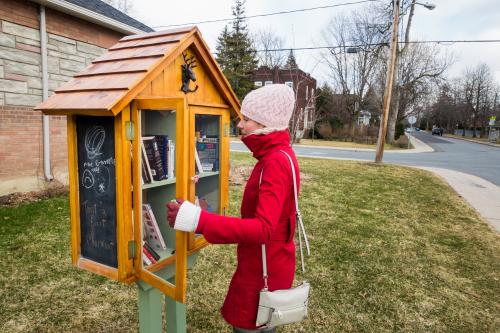 Got a bunch of extra books on hand that you probably won’t need again? Consider setting up a Little Free Library, which are popping up in cities and towns across the US. Got a bunch of extra books on hand that you probably won’t need again? Consider setting up a Little Free Library, which are popping up in cities and towns across the US.
To start one, all you do is buy or construct a box on your property—preferably at eye level. Then, pack the box with your old books and invite your neighbors and visitors to leave a book or take a book. Little Free Libraries have become so common that many people now recognize them on sight, so you shouldn’t have to put a ton of effort into starting the process.
Little Free Libraries are great ways to share resources, and they can provide a catalyst for fun conversations about books with your friends and neighbors.
Get free building and installation plans at LittleFreeLibrary.org. The site also allows you to post your library on its world map, to help others find it.
Plant a Climate Garden for All
Green America’s (Re)Store It! program aims to promote regenerative agriculture, a type of farming that builds healthy soil and turns it into a carbon sink. Now, you can get in on the action and get to know your neighbors by setting up a Climate Victory Garden for your community to share.
Any food garden can be a Climate Victory Garden (see p. 4). Inspired by the Allied Victory Gardens in WWII, these gardens turn the dirt in your backyard into a restorative, climate-cooling patch of healthy soil. All you have to do is use regenerative farming techniques like rotating plants, avoiding chemicals, planting cover crops, and more. Find resources to grow a climate garden.
And get tips on turning your garden into a community garden from the American Community Gardening Association.
Install a “Bucket List” Wall
Started by artist Candy Chang, Before I Die walls are part of a global art project that invites people to contemplate their lives and goals, and share them with others.
Communities, libraries, museums, and other venues in 70 countries have created “Before I Die” walls. The premise is simple: You set up a chalkboard or set out some sticky notes near a wall and ask people to write down a goal or dream they want to accomplish in their lifetime.
“Each wall is created by local residents who want to make a space in their community to restore perspective and share more with one another. Each wall is a tribute to living an examined life,” says the organization.
Chang released a book in 2013 with her favorite “Before I Die” responses, which include “... create a typeface of my own”; “...see where my Grandma grew up”; and “...stop being afraid.”
To view more examples and apply for free resources, visit beforeidie.city.
Share Your Stuff and Skills
The Green American has featured several ways to swap goods and share talents in past issues—like swapping child-, pet-, or elder care; starting a meal co-op; launching a home repair team; or starting a community solar project. Have other ideas? Send them to editors@greenamerica.org, and we’ll print them in a future issue.
|
|
A Living Building Challenge? Accepted! |
Buildings that simply mitigate environmental damage aim too low, says the International Living Future Institute (ILFI). People shouldn’t have to settle for buildings that don’t improve their lives and the environment around them. Now, they don’t have to thanks to the ILFI’s Living Building Challenge (LBC), which the nonprofit touts as the world’s most rigorous sustainable building certification.
The Living Building Challenge goes beyond green-building certifications, like Leadership in Energy and Environmental Design (LEED) and Cradle-to-Cradle, by elevating the goal from environmental mitigation to regeneration.
Every act of design and construction on a living building should “make the world a better place,” according to the ILFI.
The Living Building Challenge: A Building That Gives Back
As its name hints, successfully completing the Living Building Challenge is no easy feat.
To earn full certification, builders need to meet high green standards in seven focus areas, called “petals”: eco-materials, health, a sense of place, water conservation, energy efficiency, equity/accessibility, and beauty.
Builder teams earn individual petal certifications as they complete each portion of the challenge. Once they achieve all seven petals, demonstrated through performance data over 12 consecutive months, the ILFI awards full living building certification.
The ILFI uses the metaphor of a flower because, notes the organization, a living building “should operate in the same clean, efficient, low-impact manner as a flower.”
“Often when people talk about sustainability issues, they think mostly about natural resources, but the Living Building Challenge is also socially related and community related. It requires a broader way of thinking,” says Kathleen Smith, vice president of the Living Building Challenge.
This broad way of thinking transforms into action when builders meet the LBC’s seven petals:
Materials:

The LBC’s Materials Petal ensures that living buildings are made from regenerative, nontoxic materials. Projects cannot use any of the toxic and hazardous chemicals on ILFI’s Red List, which include asbestos, lead, phthalates, PVC, and more. ILFI’s “Declare” database lists the hundreds of healthier construction materials and products acceptable for use in living buildings.
Living buildings also have to use a one-time carbon offset provider to offset construction-related emissions.
To meet the LBC’s materials requirement, the project team for Washington University’s Tyson’s Living Learning Center , a fully certified Living Building in Eureka, MO, gathered woods from the Tyson Research Institute’s 2,000-acre sustainably managed forest property. The Eastern Red Cedar and Hard Maple trees in that local forest supplied wood for the Tyson Living Learning Center’s exterior sidings, trims, and floors.
Sourcing wood near the property site also fulfilled another living building mandate: that a certain amount of construction materials (as well as all hired consultants) come from the region.
The project team also replaced doors made with lead and sustainably harvested wood (which contained formaldehyde) with stainless steel, salvaged wood doors, and salvaged hardware.
Health:
Since Americans spend 90 percent of their time indoors, the buildings in which we work, learn, and live have a lasting impact on our overall health. Indoor air pollution from cleaning products and other sources can trigger respiratory problems like asthma as well as eye irritation, coughs, and headaches. 
To the creators of the LBC, health and happiness go hand in hand. In addition to developing protocols for everyday operations like cleaning, and complying with high standards for indoor air quality such as the international ASHRAE Standard 62, design teams must also embrace the idea of biophilia, or the belief that human beings have a natural desire to interact with nature.
After receiving full LBC certification in April 2015, Seattle’s Bullitt Center became the world’s first certified living office building. The Center’s project team used biophilic design as a fundamental principle guiding architecture, engineering, construction, and operation, says Denis Hayes, president and CEO of the Bullitt Foundation (and the founder of Earth Day).
“Our heavy timber structure wraps office spaces in warm, natural wood, and our large operating windows provide ample natural daylight as well as views of nature in the adjacent park,” he says. “Our occupants have responded positively to these features and many others. We know people are more productive, as well as healthier and happier, when they are able to enjoy natural daylight and surrounding views, and the tenant companies have responded favorably.”
Place:
To avoid disturbing their surrounding environment, living buildings do not occupy more space than they need. The LBC’s Place Petal requires project teams to only select sites where there is already existing development and that aren’t too close to sensitive habitats like wetlands, primary dunes, and virgin prairies. 
Living buildings promote agriculture and participate in ILFI’s Habitat Exchange program, wherein project teams match land space used for construction with purchased off-site space set aside for future habitat preservation.
Last June, the Alice Ferguson Foundation’s Morris and Gwendolyn Cafritz Foundation Environmental Center became the 13th building in the world to earn complete Living Building certification. Located on Hard Bargain Farm in Accokeek, MD, the foundation aims to connect students to the natural world, sustainable agricultural practices, and the cultural heritage of the Potomac River watershed.
“Our goal in investing in [the LBC] is so that we could truly walk the talk. It’s [also] to share what we have learned every day with the students that we serve who get to see this building in action,” says Alice Ferguson Foundation president and CEO Lori Arguelles.
She says she hopes the thousands of students who visit the center each year take what they learn from the building back home with them: “Even if your home isn’t a green building like this, it doesn’t mean that you can’t apply the principles of low water usage, or be conscious of your electricity usage, or think about composting and waste reduction through recycling.”
Water:
Changing the way people think about water waste is a major principle of the Water Petal. Living buildings capture, purify, and recycle all the water they need to operate on site.
The Cafritz Foundation Environmental Center, for instance, sits on top of a well. The Center pumps well water for drinking, showering, and washing hands, and it purifies graywater on-site. Waterless toilets and urinal composting systems also reduce water usage. A subsurface irrigation system collects and returns waste water to the ground.
Energy:
The LBC requires that buildings use on-site renewable energy systems that meet 105 percent of a living building’s energy needs, meaning that buildings must provide their own energy for everyday operation and then some. Projects usually meet the LBC’s “net-positive” energy imperative by using renewable systems, often solar, that can feed excess energy back into the grid. They must also have batteries to store energy in case of an outage.
Seattle’s Bullitt Center uses a 244 kW rooftop solar array to generate electricity. When the array produces more energy than needed, the excess energy transfers to the public utility grid, where it’s accessed by other energy users. The Bullitt Foundation, which owns the building, receives credit and is able to pull energy from the grid in the winter when there is less sunlight.
Equity: Many buildings are not constructed with people of various ages, abilities, and socioeconomic backgrounds in mind, but ILFI wants to change that. The LBC’s Equity Petal requires project teams to follow ILFI design guidelines that are “human-scaled” not only in architectural design, but in equitable accessibility, too.
Living buildings include features for disabled individuals such as ramps, sizable elevators, and windows that open to provide fresh air and sunlight.
The LBC also aims to construct buildings that are economically and regionally inclusive. ILFI recognizes that in order to achieve equitable access to nature and green buildings, outdated zoning standards that prohibit green-building practices, and private ownership that excludes communities from natural destinations and natural resources like clean air, soil, water, and lands have to change.
Home to three living buildings—the Bullitt Center, the Bertschi School Living Science Building, and McGilvra Place Park—the City of Seattle has reaped the benefits of evolving policy such as its Living Building Pilot program, which provides incentives for projects pursuing the Challenge.
“Throughout the project, the City of Seattle was an important partner, starting with the development of the Living Building Pilot Program,” says the Bullitt Foundation’s Hayes. “Such a policy framework is a critical piece of the puzzle, especially when you consider the Bullitt Center bumped up against dozens of codes and regulations—both proscriptive and prescriptive—that would otherwise have prohibited development of our forward-facing project.”
For many communities outside of Seattle, the need for pro-green building policy reform is pressing. According to a report by the peer-reviewed Environmental Health Perspectives journal, low-income and minority communities in the US currently live with the worst built-environment conditions, which exacerbates health disparities.
“If a Living Building is only for the wealthy, it’s not serving the vision of making a living future. We want everyone to have access to a living building,” says Smith. “There are even some health care organizations and hospitals that are realizing ... that the best preventative medicine and best way to reduce [health care] cost is to improve the quality of affordable housing.”
Beauty:
The LBC’s Beauty Petal isn’t as much about looks as it is about effort. Living buildings do not have to subscribe to any particular aesthetic, but they should be designed to reflect the beauty found in nature.
For many living buildings, the idea of beauty transcends physical meaning. The Te Kura Whare building in Taneatua, New Zealand, the only certified living building existing outside of the US, features the vibrant works of Tuhoe artists. Finding inspiration from traditional Tuhoe symbols, proverbs, and the surrounding Te Urewera forest region, these artworks speak to both the proud history and promising future of the Tuhoe people.
A Living Future for All
There are currently 390 projects around the world that are pursuing Living Building certification, but only 15 fully certified living buildings exist today. (However, 70 more projects have been Petal or Zero Energy certified.) The time and cost it takes to achieve all seven petals make the construction of a Living Building a true challenge with many benefits for those who complete it.
The Alice Ferguson Foundation spent 11 years and $4.8 million completing the Morris & Gwendolyn Cafritz Foundation Environmental Center. The Alice Ferguson Foundation hopes to develop case studies and an institute for ecological studies to share the information it gathered during its journey to LBC certification.
Currently, ILFI is working with eight housing developers in Alaska, DC, California, Illinois, Texas, and Washington to make living buildings more affordable and accessible. ILFI’s Affordable Housing Pilot Project borrows key principles from the Living Building Challenge to develop single-room, family, and mixed-use homes.
“Driving down the cost is in the policy advocacy we do,” says Smith. “While something may cost more up front, the strategies you use to make a living building save money in the long run. If there are incentive programs or finances in place that cover the cost, that makes [the construction process] better.”
Though persuading companies and local governments to invest in regenerative building designs might be an uphill climb, challenges seem to be ILFI’s thing.
|
|
The Bright Future of Solar Power |
Solar is booming. Solar power is now cheaper than coal in some parts of the world, and generating power from the sun is likely to be the lowest-cost energy option globally in less than ten years, according to Bloomberg. In many places around the world, solar is already the lowest-cost option.
Even the big utilities are moving rapidly toward solar (and wind, which is also poised to best coal in terms of cost). The New York Times reports that Xcel Energy—which provides electricity to the middle of the country, from Colorado to Texas to Michigan—has asked for proposals to build large wind and solar power plants in Colorado, and bids are already coming in lower than the operating costs for coal plants. West Coast energy provider Pacific Gas & Electric has committed to making renewable energy, including solar, 55 percent of its power portfolio by 2031. Many experts think that California will hit the 50 percent renewables mark by 2025—maybe even sooner.
Compounding solar’s impending energy dominance, researchers are exploring new ways to generate solar energy for human needs. Innovative methods of harnessing solar power, like stick-on solar tiles and solar roof shingles, may be coming soon to your neighborhood.
Solar Power for Every Home
Sunflare, a Los Angeles-based startup, is looking to become the next solar heavyweight with its lightweight panels. Compared to conventional solar panels, Sunflare’s panel products have the same metallic blue look, but not much else in common.
The company’s panels are thin, flexible, and lightweight. Instead of silicon and glass, Sunflare uses a stainless steel substrate with copper, indium, gallium, and selenide to make a semiconductor that’s only a few micrometers thick.

Rectangular Sunflare panels come in both standard and custom sizes. With super-thin panels come more possibilities. Rather than relying on heavy aluminum frames and skilled installers, Sunflare panels will stick almost anywhere with a special adhesive, and because they’re flexible, they can follow a curve instead of being limited to flat installations.
If a branch shades a traditional solar panel on a home’s roof, it will trigger the shutoff of that panel or a series of panels, explains Sunflare’s chief marketing officer Elizabeth Sanderson. She notes that Sunflare panels have more diodes that help bypass just the shaded area. In addition, these unique panels can be used with off-grid homes that can’t support regular panels, like trailer homes, tiny homes, or RVs.
One of Sunflare’s first customers stuck the panels onto her tiny home in Spain, allowing her to live off the grid. And Vistabule, a camping-trailer manufacturer, has worked with Sunflare to incorporate panels into the roof of its teardrop-shaped trailers.
Sanderson says she’s excited about the products’ commercial applications: “Silicon panels are four times heavier than the Sunflare panels.
Warehouses and distribution center roofs often can’t handle that kind of weight. Also, commercial building owners aren’t very happy when they have to puncture their roofs to install racking. But they are happy with Sunflare installation; it’s peel and stick. And the panels are durable and can provide more insulation for the building. It’s a win-win-win.”
Because Sunflare is in the initial phases of scale-up and in the beginning of its technology lifecycle, its prices are about 50-100 percent higher than traditional panels. However, that gap narrows as you take its much cheaper installation costs into account. Sunflare is currently ramping up as it awaits safety certification for commercial membrane roofs this month.
Solving the Storage Problem
Of course, one can’t talk about new ways to integrate solar without talking about Tesla. With its big money and perpetual media buzz, Tesla has moved quickly from the car industry into residential solar.
In the past, one big concern with solar was how to store power generated during the day for use at night. In 2015, Tesla launched its Powerwall, a giant solar-storing lithium ion battery that solves that issue. Each Powerwall battery can hold ten Kilowatt hours (kWh) of electricity. By comparison, a car battery holds about 1.2 kWh.
The Powerwall is the best-known of a few products that let people store solar energy. LG, Panasonic, BMW, and Nissan, as well as several start-up companies, all sell “home batteries” similar to the Powerwall. (Nissan uses recycled batteries from
its electric cars to power its xStorage battery, which is about $1,000 cheaper than Tesla’s.)
Solar Roof Tiles

Tesla began taking orders for its Solar Roof last May. Solar Roof tiles look identical to regular roof tiles—whether you have basic gray shingles, slate tiles, or clay Spanish tiles. But Tesla tiles generate solar power, invisibly. The Solar Roof currently comes in four styles and can be installed on the entire roof or just on the sunny side.
Consumers thought it would be years or decades before the Solar Roof would hit the market. But in January 2018, Tesla confirmed that the roofs had been installed on homes of company executives, and installation has begun at the homes of non-employee customers.
Tesla has an online calculator to estimate how much you’ll spend on a Solar Roof per month based on the size of your roof, minus the value of the energy your Solar Roof would generate and any available tax incentives. For Green America associate editor Eleanor Greene’s 990 square-foot roof in Washington, DC, and $90/month energy bill, the calculator estimated her net cost at $37/month (compared to an average $22/month for regular roof shingles) over the 30-year life of the roof’s solar capacity.
Tesla guarantees the tiles will last through the life of your house (or infinity, whichever comes first) even if the solar capacity stops working after 30 years.
Tesla recently announced it would put kiosks in 800 Home Depot stores across the country to sell its solar panels, Powerwall batteries, and Solar Roofs, and Lowe’s is in talks to sell Tesla solar products as well.
Invisible Solar Power
Though they may sound like an enviro-fantasy, solar windows could be on the market soon. A solar window is a transparent glass window that uses sunlight to create electricity, just like a solar panel.

Bad news first: solar windows are still in the development stage in the US. The purpose of a window is to let light through, but solar window technology requires striking the right balance of captured light for energy and remaining light that can brighten a room.
The good news is that companies in the US and abroad have produced solar windows that work, suggesting that these technologies may be available to consumers sooner than we think.
In 2017, SolarWindow Technologies announced a partnership with Triview Glass Industries to create SolarWindow™ products that can generate electricity. The key to this new invention is in SolarWindow Technologies’ liquid transparent coatings that make the glass act as a photovoltaic device.
Once it reaches the commercialization stage, the Maryland-based company plans to use these windows to turn skyscrapers into vertical power generators.
“Our company is essentially writing the chapter on large-area commercialization of organic photovoltaic devices and panels,” says CEO John A. Conklin.
Buildings consume 40 percent of electricity in the US, and the company anticipates that SolarWindow coatings could cut the annual $150 billion dollars it costs to pay for their electricity in half, according to company models, which feature SolarWindow on all four sides of a commercial building.
In addition to its commercial glass products, the company is developing window glass for residential homes.
Meanwhile, Physee, a power company in the Netherlands, has patented similar solar windows made with transparent double-paned glass. Physee has already successfully installed these PowerWindows in commercial office buildings in Amsterdam’s Zuidas business district and plans to install 1,850 square meters of them in Amsterdam’s BOLD apartment high-rise.
Solar Paint
In June 2017, Australia’s Royal Melbourne Institute of Technology (RMIT) announced that its researchers have developed a solar paint that could eventually generate solar power on its own.
Led by Dr. Torben Daeneke, the team invented a paint made with titanium oxide, a common ingredient in paint and sunscreen, and synthetic molybdenum-sulphide, a compound that absorbs moisture in the air. The chemical combination uses both sunlight and moisture to convert water into hydrogen fuel, as well as oxygen.
Dr. Daeneke explained to the Sydney Morning Herald that the final product of the paint would need to include membranes that can harvest hydrogen selectively for energy use.
In the past, hydrogen energy has depended on unclean processes like the burning of fossil fuels. RMIT’s paint demonstrates that hydrogen can be a clean energy source when hydrogen is generated with renewables.
Solar in the City
Danny Kennedy has been in the solar business a long time, as a clean energy advocate at Greenpeace in the ’90s who went on to found rooftop solar company Sungevity in 2007. He’s part of Green America’s Solar Circle, which has brought together industry leaders to push the solar industry into quicker progress since 2002. Now, Kennedy works with green entrepreneurs at the California Clean Energy Fund, an early stage fund for clean-energy projects, and Powerhouse, an incubator for clean-energy startups.
He’s excited about anything that makes solar easier to get to customers. But what he really gets a kick out of is seeing people starting to put solar panels in unexpected places—like solar-powered trash cans from Bigbelly. (He doesn’t have a working relationship with this company.)
“Who knew you needed that? Because solar is cheap enough for people to put an engine in a trash can, municipalities can buy trash cans that compact the trash and can call to be emptied when they’re full,” Kennedy explains. “The result is less litter on the streets and more efficient litter collection, which saves cities tens of thousands of dollars.”
Kennedy names bikesharing systems as another model that wouldn’t be the same without solar—especially dockless systems like that of the company Mobike, which Kennedy met with last summer. Mobike bikes have a solar panel in the bike basket, connecting the bike’s lock and GPS to a phone app, so customers can easily locate, reserve, and unlock the bikes they want to use. Without solar, the whole automated process would require a very expensive battery, Kennedy says. He adds that providing more bikeshare options means fewer trips by car, so it decreases traffic pollution and congestion.
A Bright Future
In 2016, solar became the fastest growing source of energy in the US, and the biggest employer of all energy industries, with around 370,000 employees, compared to 187,000 in all fossil fuels combined, according to the US Department of Labor. The price of solar fell 165 percent from 1975 to 2015, as the megawatts installed globally surged from two to 65,000 in the same period, according to a report by Bloomberg and the Earth Policy Institute.
Given the harsh realities of the climate crisis, the world’s impending approach to peak coal and peak oil, and the rapid adoption of solar worldwide, Kennedy says the future looks very bright indeed for solar power, and he expects more solar innovations to
keep coming.
“The US pioneered something world-changing, literally,” says Kennedy. “Photovoltaics, invented by Bell Labs in 1954, already have and are going to continue to completely transform civilization until we become a completely solar-powered society.”
|
|
Smarter, Safer Energy Savers |
The popularity of smart thermostats is on the rise. Devices like Google’s Nest use a feature called “geo-fencing” to use sensors in your home and the signal on your mobile phone to turn themselves to an eco-friendly lower setting while you’re away. Some take a few days to learn your heating and cooling habits, then adjust your thermostat accordingly while you’re in your house or apartment, or will allow you to program and schedule settings. Many will give you regular reports on how much energy you’re saving and send you warnings if the temperature ever plummets to the point where a pipe could burst.
You can also find smart lighting that you can dim, brighten, shift colors, and turn on and off via an app. Or smart switches that allow you to turn the devices they’re connected to on and off, program them to a timer, or even check for “phantom load” power leaks (energy that drains from a device when it’s turned off) via an app. And then there are full-house monitors that connect to your breaker box and monitor your energy use all throughout your home, generating energy-use reports and pinpointing energy drains (say it with us) via an app.
Sounds nifty, right? But nearly all the new energy-saving tech Green America’s editorial team found requires a wireless connection. And, say many experts, wireless devices may not be the healthiest things you can bring into your home.
The good news is, you can cut your home energy use by 50 percent or more without wireless.
EMF Radiation and Health
 Back in 2011, the Green American sounded a warning about EMF radiation, particularly that emitted from cell phones, since people hold them close to their heads and bodies. Back in 2011, the Green American sounded a warning about EMF radiation, particularly that emitted from cell phones, since people hold them close to their heads and bodies.
EMF radiation is produced by electricity as it moves through a wire. The National Cancer Institute notes that there are three different types of EMF radiation: extremely low frequency EMFs, like those emitted by electrical wiring and corded devices. On the other end of the spectrum are high-frequency EMFs like X-ray and gamma-ray radiation that are known to damage DNA, which can lead to cancer.
In the middle, you have radio-frequency EMFs, which are emitted by wireless networks, smart meters, cordless phones, and cell phones.
These wireless devices can harm human health, says Dr. Devra Davis, a scientist who is the president of Environmental Health Trust, lectures at top universities and medical schools, and literally wrote the book on cell phones and EMFs: Disconnect: The Truth About Cell Phone Radiation, What the Industry Has Done to Hide It, and How to Protect Your Family (Dutton, 2010).
“All wireless devices from smartphones to wireless laptops to baby monitors come with FCC warnings that they are not safe to use if held directly on the body because the radio frequency emissions can exceed government limits,” says Davis. “There is a growing body of experimental evidence showing that cell phone and wireless radiation is linked to miscarriages in pregnant women, lower sperm counts, increased brain tumors, and changes in blood markers that can lead to inflammatory conditions like arthritis and cancer.”
Cell phone and wireless radiation are the same type of radiation, says Davis. But cell phones are more of a worry since most people place them directly next to their heads, and children are handed them as toys.
“Every millimeter away gives you 15 percent less radiation,” says Davis.
But, she notes, wireless devices in close proximity to our bodies may still expose us to unhealthy amounts of EMF radiation: “For many smart tech devices, whether it’s a dryer, fridge, washing machine, we don’t even know where the wireless components are implanted. We don’t know where they’re located, how often they’re on.” And that, she says, could be a problem.
EMF Warnings Abound
In recent years, more and more respected bodies have issued warnings on wireless and cell phone radiation, particularly with children, whose bodies absorb more of it than adult bodies do.
In 2011, the World Health Organization classified radio-frequency radiation from cell phones, wireless, and other devices, as a “possible human carcinogen,” the same category into which it places jet fuel and lead.
In 2011, researchers from the National Institutes for Health released a study that found altered brain activity on PET scans when a cell phone was held up to a person’s head.
In 2011, scientists at Yale University found increased levels of hyperactivity and memory problems in mice exposed to wireless radiation in utero. Shortly thereafter, Yale and Harvard scientists issued warnings to pregnant women to reduce their exposure to wireless radiation.
In 2012, scientists at Kaiser Permanente published a replication study in Scientific Reports after finding pregnant women exposed to “real-world” levels of non-ionizing radiation (which includes EMF radiation) had nearly three times more miscarriages than women who weren’t exposed.
Belgium, France, Australia, Russia, the UK, India, Finland, Turkey, Canada, and the EU have all recommended reducing children’s exposure to wireless and cell phone radiation.
In December 2017, the state of California issued guidelines to help reduce children’s exposure to wireless and cell phone radiation.
And in February, the National Toxicology Program released the results of a multi-year study on mice and rats. It found that male rodents exposed to high levels of EMF radiation grew rare, malignant tumors in the brain and heart.
“Genome research shows that humans differ genetically from rats by three percent,” says Davis. “Every agent that we know causes cancer in humans will also produce it in animals when adequately studied.”
In addition, Davis points out that the fine print in most cell phone user manuals generally warn people to keep the phones about an inch from your body, and away from pregnant women.
Save Energy Without Wireless
While new technology can make saving energy easier to do from your couch, it’s very possible to drastically cut your home energy use without it.
In our 2010 Efficiency First! issue, we laid out techniques for improving your home efficiency by 50 percent. Find our handy, updated infographic to help you do.
For example, you can easily find an inexpensive, non-wireless programmable thermostat. Just programming your thermostat to heat or cool less when you’re away or sleeping can cut your home energy use by ten percent.
You don’t need smart switches to remind you to turn off the lights. Put a sign or sticker near your lightswitches to remind your household to avoid lighting up rooms when you’re not in them.
And you can check for phantom load energy leaks with a Kill-a-Watt meter, which will measure the energy drain of devices and appliances you plug into it.
For a more comprehensive take on plugging energy leaks, call in a Home Performance with ENERGY STAR auditor who will pinpoint areas where your home is wasting energy and give you suggestions to fix them, in addition to flagging indoor-air pollution sources.
For a DIY approach to an audit, the free Homeselfe app (iOS, Android) takes you step-by-step through your home, asking you questions about your energy use, then generates recommendations to help you make your home more energy efficient. It even connects you with local energy rebates for which you may be eligible.
Finally, installing LED bulbs uses 75 percent less energy than incandescent bulbs, and the average US home will save over $1,000 over a ten-year period, according to a 2017 cost analysis by the Consumer Federation of America.
EMF safety tips
Use these tips from Environmental Health Trust to keep yourself and your family safe from cell-phone and wireless radiation:
- Limit children’s exposure. Their smaller bodies absorb more EMF radiation than adults do.
- Distance is your friend. The amount of radiation the human body absorbs decreases by 15 percent with every millimeter away from the wireless device. Keep devices away from the body and your bedroom. And put devices on a table or desk, not your lap.
- Use the speakerphone setting on your cell phone instead of holding it against your head, or use a headset. (Corded airtube headsets are best.)
- Avoid carrying your cell phone in a pocket or bra. Carry it in a bag with the back facing away from you.
- To keep your phone or device from emitting any radiation, turn off the WiFi and Bluetooth settings and put it in airplane mode when you don’t need to be online.
- If you use your phone as an alarm clock, put it in airplane mode.
- Hard-wire devices that connect to the internet whenever possible.
- If you can’t hard-wire your home, turn off wireless routers at night.
- Use corded phones when possible. Cordless phones still emit EMF radiation, but it’s much less than that emitted by cell phones.
- Keep an eye on your signal strength. The weaker the signal, the more radiation your device emits, as it’s working harder.
- Avoid making calls while traveling in a motor vehicle or elevator. The phone works harder to get a signal through metal, so it emits more radiation.
- Never give a cell phone to young children who still put toys in their mouths.
- Reinforce the message with teens, who often sleep with their phones or carry them in a pocket
|
|
Smart Tech for a Greener Life |
Smart Roads
Roads. To an environmentally minded person, they’re something of a menace. Too often, they require bulldozing through natural habitat and laying down black asphalt that absorbs sunlight and further warms the planet. But smart highways of the future might make roads a bit better.
They could harness solar power:
In late December, China launched its first solar road, to test whether its roadway system could do double duty
by generating power from the sun.
The 1-km stretch of expressway near the city of Jinan is lined with photovoltaic tiles, sandwiched between a layer of insulation on the bottom and transparent concrete on top.
While the country’s state-run CCTV boasts that it’s the world’s first solar-panel highway, the French village of Tourouvre-au-Perche opened 1-km solar road in late 2016, with the aim of testing its energy-generating capabilities over two years.
In the US, Solar Roadways has an ongoing IndieGoGo campaign to fund its company’s research and development for domestic solar roads, plus grants from the US Department of Transportation. The company installed its solar road in an Idaho parking lot in 2011 and is currently assessing viability for a larger solar roadway system. Its roads are made of solar panels under textured, fire-and shatterproof glass, with a heating element to melt snow and ice, and LED lights for road markings.
Outlook:
Critics point out that solar roads aren’t very efficient—flat tiles mean they can’t harness the sun as well as the angled panels you see on the roof. And the glass or transparent concrete coating could prove slippery in adverse weather conditions. Plus, while the cost of solar panels keeps nosediving, tempered glass or transparent concrete is pretty much guaranteed to cost a lot more than asphalt in the long-term.
But the people at Solar Roadways say its testing shows that even accounting for flat-tile performance, replacing all US paved roads with solar roads could produce over three times the electricity the entire country uses. Plus, its solar road tiles are textured, solving the slippery road issue.
“A Solar Roadway offsets its cost over time,” the company notes on its website. “No more contributing to the climate crisis. No more dependency on fossil fuels. No more power outages. ... Safer driving conditions. Far less pollution. A new secure highway infrastructure that pays for itself. A decentralized, self-healing, secure power grid.”
They could generate electricity:

Could the mere act of driving on a road help provide energy to our communities? Sure, say scientists around the world working with piezoelectric materials. Roads made with piezoelectrics (piezo is Greek for “squeeze” or “press”) convert the pressure and vibrations from car or foot traffic into usable energy.
While it might sound like a pie-in-the-sky option to the layperson, the technology has already been proven on a smaller scale. UK-based Pavegen has installed over 150 piezoelectric walkways, including one in Washington, DC. When pedestrians walk on it, the DC walkway generates energy that turns on the LED street lamps overhead.
In mid-2017, California invested $2.3 million into two piezoelectric lengths of road. The first project, conducted by the University of California–Merced, will scatter tiny piezoelectric generators onto a 200-foot section of road on campus. The second project, from San Jose-based Pyro-e, will test a half mile of piezoelectric highway with the goal of having it power 5,000 homes.
Says Mike Ward of the California Energy Commission, which is funding the two California programs: “These pilot-scale programs will assess the technical and economic feasibility of piezoelectric systems including power output, life expectancy, durability, cost, and marketing potential.”
Outlook:
Still unknown, as piezo-electrics have never before been tested at this scale. Ward says the results from the two California projects “will help determine the feasibility of conducting future large-scale demonstrations on highways and streets.”
If successful, piezoelectrics could be a real win for the Earth and its climate.
Drive Greener Now
Greener roads won’t solve the massive amount of emissions from driving anytime soon. For that, everyone needs to reconsider their driving habits.
Drive less: The best way to cut your climate and environmental impact from driving is to not drive at all. Walk and bike whenever possible, or carpool or take public transportation. Most public systems have apps available to help you plan your trip. And the increasingly popular Waze app (iOS/Android) makes finding carpool buddies in your area easy.
Go electric: Powering a vehicle with electricity costs roughly the same as fueling one with $1/gallon gasoline, and it’s cleaner, according to Plug In America: Electric vehicles powered by our current coal-riddled grid produce 54 percent less carbon pollution than gasoline cars. If you’re worried about charging on long trips, a plug-in hybrid electric vehicle (PHEV) has a gas tank that kicks in when the battery runs out.
Consider biodiesel: Fill a diesel car up with biodiesel, a concoction of vegetable oil and alcohol, to get your driving emissions to zero. Or, you can convert your car to accept straight vegetable oil (SVO), too. Find a biodiesel station near you.
Smart Garages
As cars get greener and roads get smarter, garages are improving, too. Part of the attraction of low-emission electric and plug-in hybrid electric vehicles (EVs and PHEVs) is that they could provide renewable energy storage while they’re parked—and smart garages can help make that happen.
Solar power is, of course, available during the day. And in most places, the wind blows more strongly at night. So a conundrum engineers face over a switch to renewable energy is how to store that power for use when the sun isn’t shining or the wind isn’t blowing as much.
Enter smart garages.
Smart garages with vehicle-to-grid (V2G) capacity could pull small amounts of power from the batteries of the cars parked and plugged in inside them, sending that energy into the grid. Most garages are full during the day, as drivers go to work, and that’s also when energy use is at peak demand.
The National Renewable Energy Laboratory is currently testing a V2G smart garage on its campus. Likewise, the University of California–San Diego, with a grant from the California Energy Commission, is implementing a plan to test 50 V2G charging stations on campus.
Engineers from Tesla have expressed doubts as to whether the wear and tear on a car battery would make parking in a V2G garage economically viable for drivers in the long-term. But BMW and PG&E just completed an 18-month test of a 100-car V2G program in San Francisco, deeming the project a success. 98 percent of participants said they were satisfied with the program, which has moved on to a second phase of testing.
Smart Water Savers

Cape Town, South Africa, announced this winter that it was in crisis as its water supply is expected to dry up in mid-May. As the climate crisis hits the developing world first and worst, it’s critical that we all take steps to conserve water. While the devices below can’t replace smart homeowners who take steps to save water in their lives, they could help add on more water savings.
A Recirculating Shower: The average US shower uses 20 gallons of water. Orbital Systems aims to put the brakes on that water waste with its OAS Closed-Loop Shower (at right).
Instead of using a small pond’s worth of water, the OAS recirculates roughly 1.5 to 3.5 gallons of water, re-purifying it and adjusting pressure and temperature before it washes over you. At $3,599, however, the OAS may be too pricey for many people.
The Smarter Shower: If you’re installing a new shower and have some money to spare, you could consider the Kohler DTV Prompt with Eco-Mode Diverter ($399).
Designed to work with Kohler tub faucets and showerheads, the DTV Prompt is a digital interface that lets you customize your shower’s water pressure and temperature. The “warm-up” mode heats your water to your ideal temperature and then stops the shower until you’re ready to get in, saving water. And it includes a pause function that lets you quickly and easily stop the water flow for up to two minutes, after which your shower will resume just as you
set it.
 The device also includes a timer setting, to remind you to get out in a timely, water-saving manner. The device also includes a timer setting, to remind you to get out in a timely, water-saving manner.
The Greywater Heater: The energy used to heat water in your home, including your shower, is the second largest cost driver of utility bills, according to the US Department of Energy. Now you can recover some of that wasted heat with the EcoDrain ($575). This device captures used hot shower water as it goes down the drain uses it to heat clean water before it exits your showerhead. 
The Smart Showerhead: For a lower-priced, lower-tech option, consider the Evolve line of low-flow showerheads, sold by Florida Eco Products and others. All Evolve showerheads and tub faucets exceed EPA WaterSense thresholds for water savings.
For a smarter shower experience, look for Evolve showerhead models featuring “ShowerStart TSV,” or a Thermostatic Shut-Off Valve ($39.99 to $54.99). While they do blast water while your shower is warming up, these showerheads have sensors that detect when the water has reached a comfortable 95 degrees—at which point, they will switch to a trickle, signaling they’re ready for you to climb in. You just pull the cord to resume full flow and begin showering.
 Some Evolve models allow you to switch to a trickle whenever you like, so you don’t use as much water while you’re soaping up. Some Evolve models allow you to switch to a trickle whenever you like, so you don’t use as much water while you’re soaping up.
You can also purchase the Evolve ShowerStart TSV, an attachment that retails for $25.95 and screws in between the wall and the showerhead of your choice, giving it the same warm-up function as the Single Function and Roadrunner.
Smart Faucet: While most of the innovations for water savings seems to be around the shower, a few smart faucets may be coming to stores as well.
You might have seen infrared faucet models in public restrooms that automatically turn on when you put your hands underneath them, and turn back off again when you take your hands away. Now, you can have a faucet with that same function at home, with devices like the iTouchless EZ Faucet Adapter (from $46.64). The EZ Faucet isn’t a faucet at all, but an adapter you can screw on nearly any sink faucet to enjoy the water-saving feature.
The company says the EZ Faucet can save an average household 200 gallons of water a month. Kohler offers its DTV Prompt (see previous page) for tub faucets as well as showerheads. 
You might also find smart faucets with wireless capability and smart screens, like the Nomos from Fima Carlo Frattani. The Nomos has a touch screen that allows you to control temperature and pressure, and it also has a pause feature that heats up the water to the ideal temperature before it comes out of your tap.
However, it’s not yet clear whether the water savings of a faucet like the Nomos offsets its energy use when connected to the current power grid. And the fact that it’s wireless means it may be one to skip if you’re worried about EMF radiation.
Save water Now
You can curb your water use without fancy faucets and showerheads. Green America’s recent article, “13 Ways to Save 65+ Gallons of Water a Day” includes several tips to lower your water waste. The top savers we found are taking five-minute showers (a simple timer can help), fixing leaks in your home, and washing full loads of laundry and dishes.
In addition, conventional low-flow showerheads, toilets, and faucets offer water savings without complex gadgetry. Find green businesses offering smart and analog water-saving tools in the “Water Conservation” category at Green America’s GreenPages.org.
Smart Air Monitors
Green America has often recommended getting a Home Performance with ENERGY STAR audit, because this type of audit not only thoroughly points out energy leaks in your home but will also give you ways you can improve indoor-air quality. Now, new smart monitors can provide some of the same indoor-air monitoring 24/7.
The uHoo ($199) tracks airborne chemicals and particulate matter inside your home, letting you know when levels are too high for health. It also tracks carbon monoxide, ozone, CO2, humidity, and temperature.
In addition, it provides charts tracking your indoor air over time, so you can easily identify pollution sources and patterns. And it’ll send you alerts via a cell phone app if your levels are unhealthy.
The Foobot ($179) detects invisible air pollutants inside your home, letting you know which are occurring and in what quantities via an LED display. In particular, it looks at chemical pollutants and particulate matter, as well as temperature and humidity.
Like the uHoo, it provides charts tracking your indoor air over time, so you can easily identify pollution sources and patterns. And it will compare your indoor air to your geo-located outdoor air, letting you know if you’ll get some relief by opening the windows or not.
The Awair ($165) tracks dust, chemicals, CO2, relative humidity, and temperature. It’ll also send you personalized recommendations via an app for cleaning up the air inside your home.
You’ll need WiFi to set all three up and take advantage of all features. After setup, the Foobot will work offline. You’ll just forgo the feature that allows you to send data to the cloud and get back personalized recommendations. The uHoo turns off completely (including WiFi signal) when it’s not actively monitoring—which happens once every minute for ten seconds or less. But if you have hard-wired your internet for safety, neither it nor the Awair will work sans wireless.
|
|
Green Tech for the Future |
It’s called the “Internet of Things,” a term coined by Procter & Gamble exec Kevin Ashton in 1999. It means an interconnected web of appliances, devices, cars, and other technology that are able to “talk” to each other and share data. Considering the vast reach and scope of the internet, adding a bunch of “things” to it may not sound all that sustainable. The last thing the Earth and our busy lives need is more stuff. But, like it or not, the Internet of Things is on its way.
Green America doesn’t suggest you overload your home with wireless devices, due to the health concerns around electromagnetic frequency radiation. But maybe there’s a way to harness some of the new (non-wireless) tech for good.
Up-and-coming roads, for example, could help the world harness enough clean, renewable energy to meet all of our power needs and them some.
New devices aimed at upping energy- and water-efficiency save precious resources and save homeowners money.
Innovative ways of harnessing solar power for your home—from solar windows to solar paint to flexible, stick-on solar panels—can make it easier for every homeowner to go solar.
And don’t forget that in our previous issue of the Green American, bestselling author Paul Hawken and the scientists at his new nonprofit Project Drawdown said that better methods of refrigeration, at home and commercially, is the number one solution for drawing down greenhouse gas emissions and solving the climate crisis. Our associate editor Eleanor Greene takes a deep dive into how that could be done.
Green Americans undoubtedly know that buying new devices, appliances, and cars just to get in on the latest fad can be hugely wasteful. It can also adversely impact workers, as overseas factories may cut corners on worker safety and implement forced overtime hours—without extra pay—to meet high demand. But our editors took a look at some of the new tech that’s either just launching or coming soon, and some of it could help society take the next step toward a cleaner, greener future.
|
|
Events Calendar |
|
|
Clean Energy is Calling |
|
|
New Green Tech: Promise and Pitfalls |
For better or worse, a vast array of new technology is becoming smarter, more interconnected, and able to churn out mind-boggling sets of data. While some of that tech is merely interesting or adds convenience (and waste!), some might help make our lives greener in the years to come.
|
|
Own Stocks? Vote your Values! |
You have the power to vote for company resolutions that affect people and the planet.
|
|
Clean Energy is Calling Report |
|
|
Methods of Regenerative Agriculture: #3 Cover Crops & Crop Rotation |
This is the third blog of a series describing the five methods that make up regenerative agriculture—perennial plants & diverse crops, zero/low tillage & mulching, cover cropping & crop rotation, composting, and managed grazing. Implementation of these methods is site specific and depends on soil characteristics, crops grown, and local climates. Practices are rooted in organic methods and can be integrated into farms and pastures transitioning from conventional to organic. They also have a role in smaller-scale climate gardens, where individuals do their part to sequester carbon and contribute to a local, sustainable food system.
All agriculture sequesters carbon from the air through photosynthesis. But, regenerative agriculture ensures more carbon is stored than released and keeps the drawn down carbon underground. This effectively reduces the amount of carbon dioxide in the atmosphere and increases the amount of soil carbon available for healthy crops.
Crop Rotation & Cover Crops
In agriculture, there is major potential for cover cropping and crop rotation to provide beneficial outcomes for the climate and beyond. In modern-day industrial agriculture, lands are often planted with a single crop year after year and/or tilled and left bare (fallow) for long periods of time (aka monocropping). Regenerative agriculture, on the other hand, incorporates the wisdom of including both diverse cover crops and crop rotations. Cover cropping—the growing of beneficial plants during these times of rest or in combination with the primary crop—significantly reduces soil erosion and agricultural runoff from rainstorms or irrigation. Rotating crops across many fields, rather than planting the same monocrop in one location year after year, is another practice that encourages restoration of healthy soil ecosystems.
Farmers can enhance their carbon storage potential by adding mixed species of cover crops and diversifying cropping rotations—both build soil health, store more carbon, and help keep soils covered and their micro-biome (communities of microbes) nurtured year-round. The practices reduce erosion, improve the water holding capacity of soils, and even provide important wildlife habitats.
Cover crops include wheat, barley, peas, clovers, and many others (often grown in mixes), and can be used in consumer products like beers and cereals. The longer a cover crop is maintained and the diversification of the species used—often called a cover crop cocktail—enhance this practice’s ability to restore soil health and increase farmer profitability. Farmers can choose cover crops that use nature to supply their crops with organic nitrogen and rebuild many other key aspects of soil health at the same time. While many farmers recognize these benefits, current crop insurance policies limit farmers’ use of cover crops because the programs are based on outdated science and don’t take into consideration the new information known about cover crops, risk, and nutrient loss reduction strategies.

Similarly, crop rotation helps farmers reduce loss of soil nutrients and the need for petrochemical-based fertilizers and pesticides because their whole farming system encourages healthy soil and provides more natural resistance to pests. This twofold benefit is critical for the health of our communities, as chemical drift and contaminated surface and ground water is a major health threat. This practice also has the potential to provide more nutrient-dense crops for our own healthy diets and increased food security.
If you’re a climate gardener, there’s major potential for you and your garden to benefit from cover cropping and rotating your crops. This resource from the USDA that has in-depth information on all the cover crops you might consider for your specific situation and needs—there is an incredible diversity of options. And, while you may find yourself habitually planting tomatoes in the same place year after year, spend some time thinking about alternative plans to help manage soil fertility (for example, some plants consume much more of some soil nutrients than others) and possible diseases and pests (for example, some families of vegetables attract similar pests, so should be alternated to reduce the likelihood of these specific pests becoming a significant issue).
Whether you’re a consumer, farmer, or climate gardener, cover cropping and crop rotations are important. They are just two of the many tools and practices that make up a regenerative agricultural system and bring many benefits to local ecosystems and the people involved from food production to consumption.
If you do not have access to a garden or farmland, and you’re unable to implement these practices directly, use your consumer power and speak with your dollars to show your support for these important practices. Make your opinion heard when crop insurance policies are being debated in the farm bill. Without strong signals from consumers, and demand from food companies large and small, not enough farmers will switch to these practices in the timeframe needed to reverse current climate trends that threaten food security and the future of our planet. If you have a favorite product or retailer, let them know that you support regenerative agriculture and want to see them sell products that support soil and climate health.
SaveSave
|
|
TomatoInk.com |
TomatoInk.com is an eco-friendly, low-cost provider of ink and toner. By packaging ink in remanufactured cartridges, we pass along substantial financial and environmental savings to customers. Our products give the same vibrant, high-quality results that you expect from the name brands but at prices up to 80% less! Combine that with our OneTreePlanted partnership, and you can print with ease knowing TomatoInk is thinking about you and the world you live in.
Save a little green, grow a little green.
|